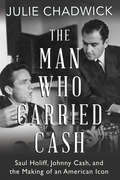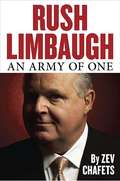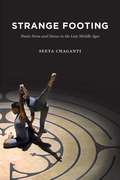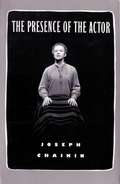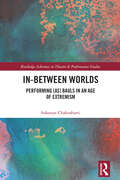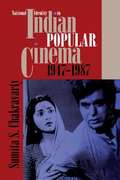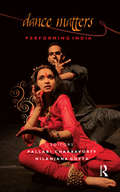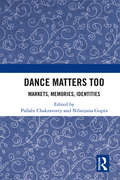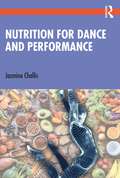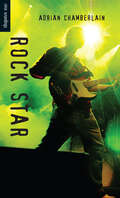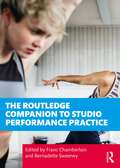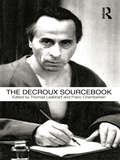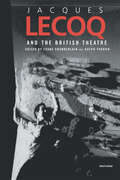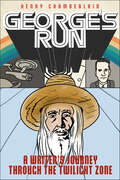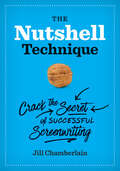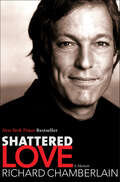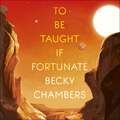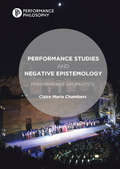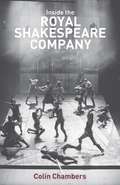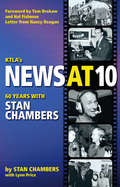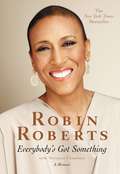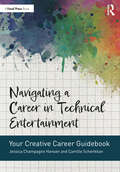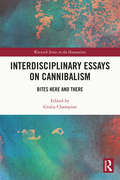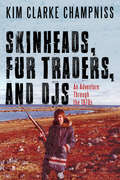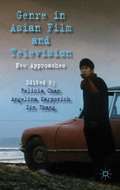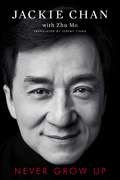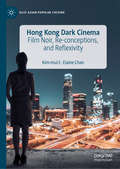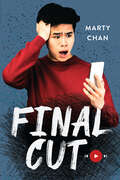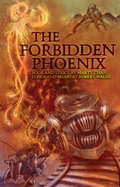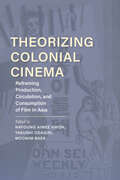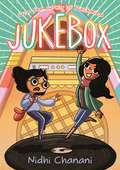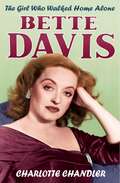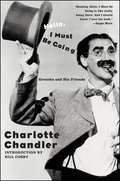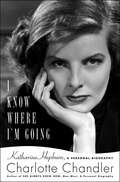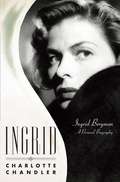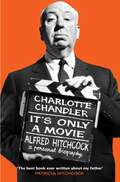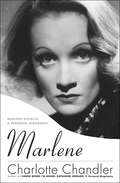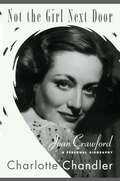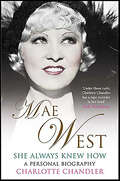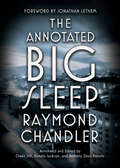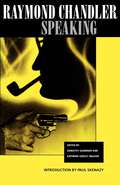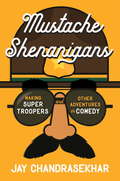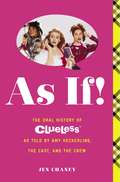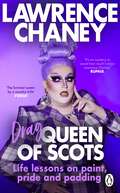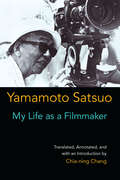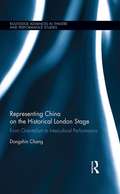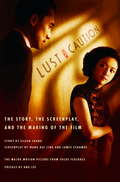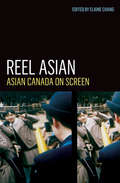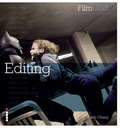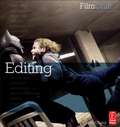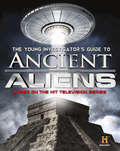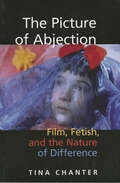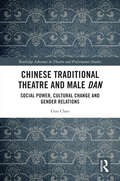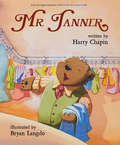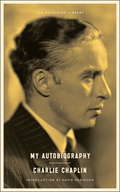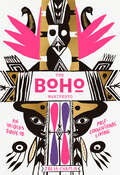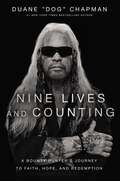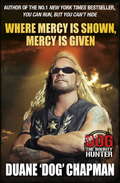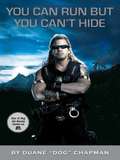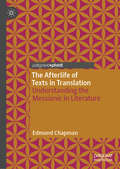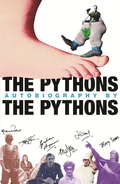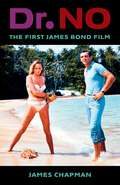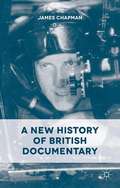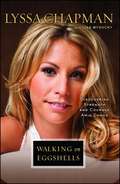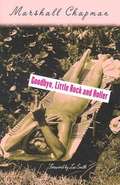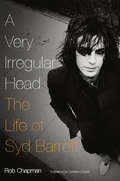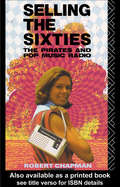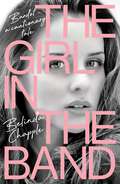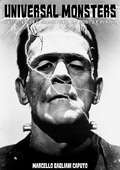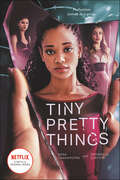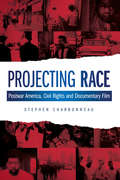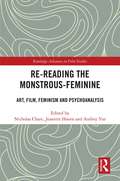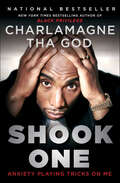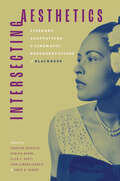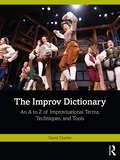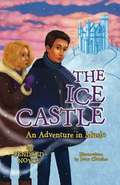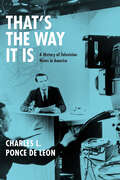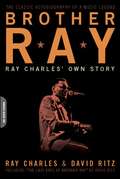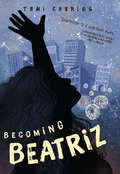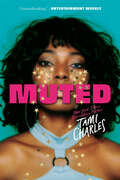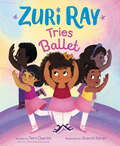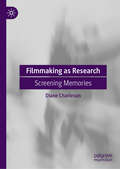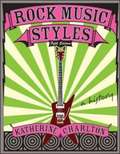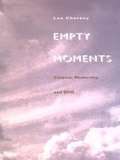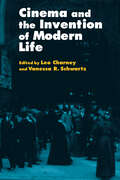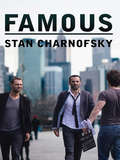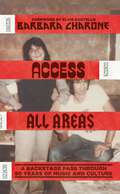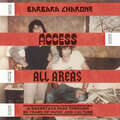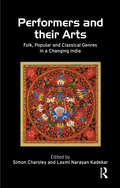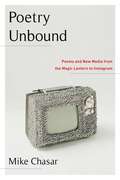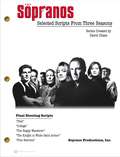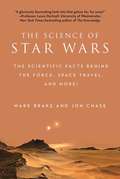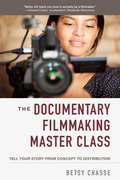The Man Who Carried Cash: Saul Holiff, Johnny Cash, and the Making of an American Icon
by Julie ChadwickThe unlikely, rocky relationship between an American country superstar and his straightlaced Canadian manager. Before there was Johnny and June, there was Johnny and Saul. The Man Who Carried Cash chronicles a relationship that was both volatile and affectionate between Johnny Cash and his manager, Saul Holiff. From roadside taverns to the roaring crowds at Madison Square Garden, from wrecked cars and jail cells all the way to the White House, the story of Johnny and Saul is a portrait of two men from different worlds who were more alike than either cared to admit. Saul handled the bookings and the no-shows, the divorce and the record deals, drugs, overdoses, and arrests. He was there for the absolute worst of times, but also for the best: Carnegie Hall, Folsom Prison, “A Boy Named Sue,” and Cash’s hit television series. But in 1973, at the zenith of Cash’s career, Saul quit. Until now, no one knew why.
Rush Limbaugh: An Army of One
by Zev Chafets"I know the liberals call you 'the most dangerous man in America,' but don't worry about it, they used to say the same thing about me. Keep up the good work. " -Ronald Reagan in a letter to Rush Limbaugh, December 11, 1992. Do you remember your first time? People tend to remember the moment they first heard The Rush Limbaugh Show on the radio. For Zev Chafets, it was in a car in Detroit, driving down Woodward Avenue. Limbaugh's braggadocio, the outrageous satire, the slaughtering of liberal sacred cows performed with the verve of a rock-n-roll DJ-it seemed fresh, funny and completely subversive. "They're never going to let this guy stay on the air," he thought. Almost two decades later Chafets met Rush for the first time, at Limbaugh's rarely visited "Southern Command. " They spent hours together talking on the record about politics, sports, music, show business, religion and modern American history. Rush opened his home and his world, introducing Chafets to his family, closest friends, even his psychologist. The result was an acclaimed cover-story profile of Limbaugh in The New York Times Magazine. But there was much more to say, especially after Limbaugh became Public Enemy Number One of the Obama Administration. At first Limbaugh resisted the idea of a full-length portrait, but he eventually invited Chafets back to Florida and exchanged more than a hundred emails full of his personal history, thoughts, fears and ambitions. What has emerged is an uniquely personal look at the man who is not only the most popular voice on the radio, but the leader of the conservative movement and one of the most influential figures in the Republican Party. While Limbaugh's public persona is instantly recognizable, his background and private life are often misunderstood. Even devoted Dittoheads will find there's a lot they don't know about the self-described "harmless little fuzzball" who has, over the years, taken on the giants of the mainstream media and the Democratic Party-from Bill and Hillary Clinton to Barack Obama-with "half his brain tied behind his back, just to make it fair. " Chafets paints a compelling portrait of Limbaugh as a master entertainer, a public intellectual, a political force, and a fascinating man.
Strange Footing: Poetic Form and Dance in the Late Middle Ages
by Seeta ChagantiFor premodern audiences, poetic form did not exist solely as meter, stanzas, or rhyme scheme. Rather, the form of a poem emerged as an experience, one generated when an audience immersed in a culture of dance encountered a poetic text. Exploring the complex relationship between medieval dance and medieval poetry, Strange Footing argues that the intersection of texts and dance produced an experience of poetic form based in disorientation, asymmetry, and even misstep. Medieval dance guided audiences to approach poetry not in terms of the body’s regular marking of time and space, but rather in the irregular and surprising forces of virtual motion around, ahead of, and behind the dancing body. Reading medieval poems through artworks, paintings, and sculptures depicting dance, Seeta Chaganti illuminates texts that have long eluded our full understanding, inviting us to inhabit their strange footings askew of conventional space and time. Strange Footing deploys the motion of dance to change how we read medieval poetry, generating a new theory of poetic form for medieval studies and beyond.
The Presence of the Actor
by Joseph ChaikinChaikin, who directed the celebrated Open Theater in the '60s, kindled an emphasis on communal playmaking whose impact is still evident today. This conversational review of his efforts details his methods and reveals the struggles involved in the creation of some of the most exciting theatre of our time.
In-Between Worlds: Performing [as] Bauls in an Age of Extremism (Routledge Advances in Theatre & Performance Studies)
by Sukanya ChakrabartiThis book examines the performance of Bauls ‘folk’ performers from Bengal, in the context of a rapidly globalizing Indian economy and against the backdrop of extreme nationalistic discourses. Recognizing their scope beyond the musical and cultural realm, Sukanya Chakrabarti engages in discussing the subversive and transformational potency of Bauls and their performances. In-Between Worlds argues that the Bauls through their musical, spiritual, and cultural performances offer ‘joy’ and ‘spirituality,’ thus making space for what Dr. Ambedkar in his famous 1942 speech had identified as ‘reclamation of human personality’. Chakrabarti destabilizes the category of ‘folk’ as a fixed classification or an origin point, and fractures homogeneous historical representations of the Baul as a ‘folk’ performer and a wandering mendicant exposing the complex heterogeneity that characterizes this group. Establishing ‘folk-ness’ as a performance category, and ‘folk festivals’ as sites of performing ‘folk-ness,’ contributing to a heritage industry that thrives on imagined and recreated nostalgia, Chakrabarti examines different sites that produce varied performative identities of Bauls, probing the limits of such categories while simultaneously advocating for polyvocality and multifocality. While this project has grounded itself firmly in performance studies, it has borrowed extensively from fields of postcolonial studies and subaltern histories, literature, ethnography and ethnomusicology, and cosmopolitan studies.
National Identity in Indian Popular Cinema, 1947-1987
by Sumita S. ChakravartyAlthough Indian popular cinema has a long history and is familiar to audiences around the world, it has rarely been systematically studied. This book offers the first detailed account of the popular film as it has grown and changed during the tumultuous decades of Indian nationhood. The study focuses on the cinema's characteristic forms, its range of meanings and pleasures, and, above all, its ideological construction of Indian national identity.<P><P>Informed by theoretical developments in film theory, cultural studies, postcolonial discourse, and "Third World" cinema, the book identifies the major genres and movements within Bombay cinema since Independence and uses them to enter larger cultural debates about questions of identity, authenticity, citizenship, and collectivity. Chakravarty examines numerous films of the period, including Guide (Vijay Anand, 1965), Shri 420 [The gentleman cheat] (Raj Kapoor, 1955), and Bhumika [The role] (Shyam Benegal, 1977). She shows how "imperso-nation," played out in masquerade and disguise, has characterized the representation of national identity in popular films, so that concerns and conflicts over class, communal, and regional differences are obsessively evoked, explored, and neutralized.
Dance Matters: Performing India on Local and Global Stages
by Pallabi Chakravorty Nilanjana GuptaThis volume presents a multidisciplinary perspective on dance scholarship and practice as they have evolved in India and its diaspora, outlining how dance histories have been written and re-written, how aesthetic and pedagogical conventions have changed and are changing, and how politico-economic shifts have shaped Indian dance and its negotiation with modernity.. Written by eminent and emergent scholars and practitioners of Indian dance, the articles make dance a foundational socio-cultural and aesthetic phenomena that reflects and impacts upon various cultural intercourses -- from art and architecture to popular culture, and social justice issues. They also highlight the interplay of various frameworks: global, national, and local/indigenous for studying these diverse performance contexts, using dance as a critical lens to analyse current debates on nationalism, transnationalism, gender and sexuality, and postcolonial politics. At the performace level, some articles question the accepted divisions of Indian dance (‘classical’, ‘folk’, and ‘popular’) and critique the dominant values associated with classical dance forms. Finally, the book brings together both experiential and objective dimensions of bodily knowledge through dance.
Dance Matters Too: Markets, Memories, Identities
by Pallabi Chakravorty Nilanjana GuptaDance Matters Too: Markets, Memories, Identities is a rich intellectual contribution to the growing field of dance studies in India. It forges new avenues of scholarly inquiry and critical engagement and opens the field in innovative ways. This volume builds on Dance Matters (2009), which mapped the interdisciplinary breadth of the field. The chapters presented here continue to underline the uniqueness of a field that is a blend of critical scholarship on aesthetics and performance with the humanities and social sciences. Including diverse material, analytical approaches and perspectives from scholars and practitioners, this multidimensional volume explores debates on dance preservation and tradition in globalizing India, multimedia choreographies and the circulation of dance via electronic media, embodiment and memory, power, democracy and bourgeoning markets, classification and censorship, and corporatization and Bollywood. This tour de force will appeal to those in dance and performance studies, cultural studies, sociology as well as to readers interested in tradition, modernity, gender and globalization.
Nutrition for Dance and Performance
by Jasmine ChallisNutrition for Dance and Performance is the first complete textbook written by an experienced dietitian specialising in the field of dance nutrition. It seeks to provide both dancers-in-training and instructors with practical advice on dance nutrition for health and performance. It is also highly relevant for dance professionals. With an in-depth and extensive coverage on all nutrition topics relevant to dancers, this book covers nutrition for the scenarios dancers face, including day-to-day training and rehearsals, peak performance, injuries, immunonutrition, nutrition and stress management. Information is included on topics applicable to individual dancers including advice for dancers with Type 1 diabetes and clinical conditions relating to gut health. The book guides the reader through the macronutrients making up the diet, their chemical structure and their role in health and optimal performance. Readers are shown how to estimate energy and nutrient needs based on their schedule, type of dance undertaken and personal goals before considering the practical aspects of dance nutrition; from nutrition planning to dietary supplements, strategies for assessing the need to alter body composition and guidance on undertaking health-focused changes. Nutrition for Dance and Performance combines and condenses the author’s knowledge and many years of experience working in the dance industry to translate nutrition science into a practical guide. Bringing together the latest research in dance science and nutrition, this book aims to be a trusted reference and practical textbook for students of Dance, Dance Nutrition, Dance Performance, Sport Nutrition and Sport Science more generally as well as for those training in the dance industry, dance teachers and professionals. Jasmine Challis is a freelance Registered Nutritionist (UK Association for Nutrition) and Dietitian registered with the Health Care Professions Council, and is on the UK Sport and Exercise Nutrition Register (SENR) focusing on dance. She completed an MRes in Sport and Exercise Science in 2018. She is on the Dance Medicine and Science Expert Panel for One Dance UK and is on the board of The Bridge Dance Project. She has worked across the dance field for over 30 years giving talks, running workshops and providing 1:1 sessions for dancers and dance students.
Rock Star (Orca Soundings)
by Adrian ChamberlainStruggling at home and at school, Duncan decides to try out for a local rock band. He plays the bass in the school orchestra, but it is a long way from band camp to rock star. Joining a heavy-metal band, he tries to fit in, dumping his old friends and trying to walk the walk. When his dad's new girlfriend starts to teach him about real rock music and introduces him to her musician brother, Duncan discovers that there is more to being a guitar hero than playing in a heavy-metal band.
The Routledge Companion to Studio Performance Practice
by Franc ChamberlainThe Routledge Companion to Studio Performance Practice is a unique, indispensable guide to the training methods of the world’s key theatre practitioners. Compiling the practical work outlined in the popular Routledge Performance Practitioners series of guidebooks, each set of exercises has been edited and contextualised by an expert in that particular approach. Each chapter provides a taster of one practitioner’s work, answering the same key questions: ‘How did this artist work? How can I begin to put my understanding of this to practical use?’ Newly written chapter introductions put the exercises in context, explaining how they fit into the wider methods and philosophy of the practitioner in question. All 21 volumes in the original series are represented in this volume.
The Decroux Sourcebook
by Franc Chamberlain Thomas LeabhartThe Decroux Sourcebook is the first point of reference for any student of the ‘hidden master’ of twentieth century theatre. This book collates a wealth of key material on Etienne Decroux, including: an English translation of Patrice Pezin’s ‘Imaginary Interview’, in which Decroux discusses mime’s place in the theatre. previously unpublished articles by Decroux from France’s Bibiothèque Nationale. essays from Decroux’s fellow innovators Eugenio Barba and Edward Gordon Craig, explaining the synthesis of theory and practice in his work. Etienne Decroux’s pioneering work in physical theatre is here richly illustrated not only by a library of source material, but also with a gallery of images following his life, work and influences. The Decroux Sourcebook is an ideal companion to Thomas Leabhart’s Etienne Decroux in the Routledge Performance Practitioners series, offering key primary and secondary resources to those conducting research at all levels.
Jacques Lecoq and the British Theatre
by Franc Chamberlain Ralph YarrowJacques Lecoq and the British Theatre brings together the first collection of essays in English to focus on Lecoq's school of mime and physical theatre. For four decades, at his school in Paris, Jacques Lecoq trained performers from all over the world and effected a quiet evolution in the theatre. The work of such highly successful Lecoq graduates as Theatre de Complicite (The Winter's Tale with the Royal Shakespeare Company and The Visit, The Street of Crocodiles and The Causcasian Chalk Circle with the Royal National Theatre) has brought Lecoq's work to the attention of mainstream critics and audiences in Britain. Yet Complicte is just the tip of the Iceberg. The contributors to this volume, most of them engaged in applying Lecoq's work, chart some of the diverse ways in which it has had an impact on our conceptions of mime, physical theatre, actor training, devising street theatre and interculturalism. This lively - even provocative - collection of essays focuses academic debate and raises awareness of the impact of Lecoq's work in Britain today.
George's Run: A Writer's Journey through the Twilight Zone
by Henry ChamberlainGeorge Clayton Johnson was an up-and-coming short story writer who broke into Hollywood in a big way when he co-wrote the screenplay for Ocean’s Eleven. More legendary works followed, including Logan’s Run and classic scripts for shows like The Twilight Zone and Star Trek. In the meantime, he forged friendships with some of the era’s most visionary science fiction writers, including Ray Bradbury, Theodore Sturgeon, Richard Matheson, and Rod Serling. Later in life, Johnson befriended comics journalist and artist Henry Chamberlain, and the two had long chats about his amazing life and career. Now Chamberlain pays tribute to his late friend in the graphic novel George’s Run, which brings Johnson’s creative milieu to life in vividly illustrated color panels. The result feels less like reading a conventional biography and more like sitting in on an intimate conversation between friends as they recollect key moments in pop culture history, as well as the colorful band of writers known as the “Rat Pack of Science Fiction.”
The Nutshell Technique: Crack the Secret of Successful Screenwriting
by Jill ChamberlainA veteran Hollywood script consultant unlocks the secrets of storytelling in this &“clever, fresh way of analyzing structure&” (Creative Screenwriting magazine). Veteran script consultant Jill Chamberlain knows that most first-time screenwriters don&’t understand how to tell a story. These writers may have snappy dialogue, interesting characters, and clever plot devices—but what they deliver isn&’t a story. It&’s a situation. In order to explain the difference, Chamberlain created the Nutshell Technique, a method whereby writers identify eight dynamic, interconnected elements that are required to successfully tell a story. In this book, Chamberlain uses easy-to-follow diagrams (&“nutshells&”) to explain how the Nutshell Technique can make or break a film script. She takes readers step-by-step through thirty classic and contemporary movies, showing how such dissimilar screenplays as Casablanca, Chinatown, Pulp Fiction, Little Miss Sunshine, Juno, and Argo all have the same system working behind the scenes. She then teaches readers how to apply these principles to their own screenwriting.
The Nutshell Technique: Crack the Secret of Successful Screenwriting
by Jill ChamberlainA veteran Hollywood script consultant unlocks the secrets of storytelling in this &“clever, fresh way of analyzing structure&” (Creative Screenwriting magazine). Veteran script consultant Jill Chamberlain knows that most first-time screenwriters don&’t understand how to tell a story. These writers may have snappy dialogue, interesting characters, and clever plot devices—but what they deliver isn&’t a story. It&’s a situation. In order to explain the difference, Chamberlain created the Nutshell Technique, a method whereby writers identify eight dynamic, interconnected elements that are required to successfully tell a story. In this book, Chamberlain uses easy-to-follow diagrams (&“nutshells&”) to explain how the Nutshell Technique can make or break a film script. She takes readers step-by-step through thirty classic and contemporary movies, showing how such dissimilar screenplays as Casablanca, Chinatown, Pulp Fiction, Little Miss Sunshine, Juno, and Argo all have the same system working behind the scenes. She then teaches readers how to apply these principles to their own screenwriting.
Shattered Love: A Memoir
by Richard ChamberlainIn Shattered Love, Richard Chamberlain poignantly recounts his lifelong struggle to find happiness. Tracing a fascinating path over his meteoric rise to success, he chronicles his struggle to come to terms with his own imperfections, his growing desire to be honest about his sexual orientation, and his yearning to live with an open heart. And along the way he imparts the lessons he has learned about overcoming our own self–imposed obstacles to happiness.
To Be Taught, If Fortunate: A Novella
by Becky ChambersIn the future, instead of terraforming planets to sustain human life, explorers of the galaxy transform themselves.*FROM THE SUNDAY TIMES BESTSELLING AUTHOR* At the turn of the twenty-second century, scientists make a breakthrough in human spaceflight. Through a revolutionary method known as somaforming, astronauts can survive in hostile environments off Earth using synthetic biological supplementations. They can produce antifreeze in sub-zero temperatures, absorb radiation and convert it for food, and conveniently adjust to the pull of different gravitational forces. With the fragility of the body no longer a limiting factor, human beings are at last able to explore neighbouring exoplanets long suspected to harbour life.Ariadne is one such explorer. On a mission to ecologically survey four habitable worlds fifteen light-years from Earth, she and her fellow crewmates sleep while in transit, and wake each time with different features. But as they shift through both form and time, life back on Earth has also changed. Faced with the possibility of returning to a planet that has forgotten those who have left, Ariadne begins to chronicle the wonders and dangers of her journey, in the hope that someone back home might still be listening.(P) 2019 Hodder & Stoughton Ltd
Performance Studies and Negative Epistemology
by Claire Maria ChambersThis book argues that apophaticism continues to exert strong influence in Western cultural discourses, especially performance. While apophaticism in the academy may have had its heyday in the debates about negative theology and deconstruction in the 1990s, negative knowledges have continued to influence theatre and performance studies around issues of embodiment, the non- and post-human, objects, archives, the ethics of otherness, and the inaccessible in the work of minority artists. Part of the history of apophaticism lies in mystic literature; with the rise of the New Age movement, which claimed historical mysticism as its predecessor, apophaticism has often been sidelined as spirituality rather than serious study. By reassessing ancient forms of negative epistemology, this book suggests that artists, scholars, students and teachers alike can more deeply engage forms of unknowing through what cannot be spoken and cannot be represented, both on the stage and in every aspect of social life.
Inside the Royal Shakespeare Company: Creativity and the Institution
by Colin ChambersThis is the inside story of the Royal Shakespeare Company - a running historical critique of a major national institution and its location within British culture, as related by a writer who is uniquely placed to tell the tale. It describes what happened to a radical theatrical vision and explores British society's inability to sustain that vision. Spanning four decades and four artistic directors, Inside the Royal Shakespeare Company is a multi-layered chronicle that traces the company's history, offers investigation into its working methods, its repertoire, its people and its politics, and considers what the future holds for this bastion of high culture now in crisis. Inside the Royal Shakespeare Company is compelling reading for anyone who wishes to explore behind the scenes and consider the changing role of theatre in modern cultural life. It offers a timely analysis of the fight for creative expression within any artistic or cultural organisation, and a vital document of our times.
KTLA's News At 10: Sixty Years with Stan Chambers
by Stan Chambers Hal Fishman Tom BrokawOver sixty years at KTLA News and twenty-two thousand stories, Stan Chambers, the godfather of Los Angeles newsies, has the unique distinction of being the first to break many nation-rocking stories. Stan steps out from behind the microphone to tell his side of the story and chronicles the evolution of the televised news world.
Everybody's Got Something
by Veronica Chambers Robin Roberts"Regardless of how much money you have, your race, where you live, what religion you follow, you are going through something. Or you already have or you will. As momma always said, "Everybody's got something." So begins beloved Good Morning America anchor Robin Roberts's new memoir in which she recounts the incredible journey that's been her life so far, and the lessons she's learned along the way. With grace, heart, and humor, she writes about overcoming breast cancer only to learn five years later that she will need a bone marrow transplant to combat a rare blood disorder, the grief and heartbreak she suffered when her mother passed away, her triumphant return to GMA after her medical leave, and the tremendous support and love of her family and friends that saw her through her difficult times. Following her mother's advice to "make your mess your message," Robin taught a nation of viewers that while it is true that we've all got something -- a medical crisis to face, aging parents to care for, heartbreak in all its many forms --- we've also all got something to give: hope, encouragement, a life-saving transplant or a spirit-saving embrace. As Robin has learned, and what readers of her remarkable story will come to believe as well, it's all about faith, family and friends. And finding out that you are stronger, much stronger, than you think.
Navigating a Career in Technical Entertainment: Your Creative Career Guidebook
by Jessica Champagne Hansen Camille SchenkkanNavigating a Career in Technical Entertainment: Your Creative Career Guidebook explores tools, strategies, and motivational advice from a wide range of industry professionals for navigating an artistic career in design and technology in entertainment. This book is designed to accompany readers every step of the way in their career journey – from landing their first job after school through mid-career pivots and switching industries. It is organized into four parts: Finding Your Career Path; Tools and Strategies for Navigating Your Career Path; Curating a Creative Community as You Sustain Your Career; and Maintaining Flexibility and Finding Fulfillment in Your Career. Filled with motivational advice from mentors in the industry and creative worksheet exercises for personalized career planning, self- reflection, and goal setting, this book demystifies a complex industry, sharing crucial career-related information rarely covered in formal training programs. It explores a wide range of topics, including the types of jobs available in live entertainment and TV/film, education options, job searching, networking, career marketing materials, interviews, unions, financial empowerment, and refocusing on career shifts. This guidebook is written for designers, technicians, stage managers, production managers, crew members, and creative technical artists in entertainment at all stages of their career. Covering a wide variety of entertainment from theater and television to commercials and theme parks, Navigating a Career in Technical Entertainment is a perfect companion for higher education or postsecondary educators and students exploring career and workforce readiness topics and can also be used by professionals actively working in the field. This text also includes access to downloadable versions of the worksheets featured in the book, available at www.routledge.com/9780367510442.
Interdisciplinary Essays on Cannibalism: Bites Here and There (Warwick Series in the Humanities)
by Giulia ChampionInterdisciplinary Essays on Cannibalism: Bites Here and There brings together a range of works exploring the evolution of cannibalism, literally and metaphorically, diachronically and across disciplines. This edited collection aims to promote a conversation on the evolution and the different uses of the tropes and figures of cannibalism, in order to understand and deconstruct the fascination with anthropophagy, its continued afterlife and its relation to different disciplines and spaces of discourse. In order to do so, the contributing authors shed a new light not only on the concept, but also propose to explore cannibalism through new optics and theories. Spanning 15 chapters, the collection explores cannibalism across disciplines and fields from Antiquity to contemporary speculative fiction, considering history, anthropology, visual and film studies, philosophy, feminist theories, psychoanalysis and museum practices. This collection of thoughtful and thought-provoking scholarly contributions suggests the importance of cannibalism in understanding human history and social relations.
Skinheads, Fur Traders, and DJs: An Adventure Through the 1970s
by Kim Clarke ChampnissThe true story of a legend of Canadian pop culture broadcasting and the way he got his start in the 1970s: working as a fur trader for the Hudson’s Bay Company in the Northwest Territories and then moving on to DJing in disco-era Vancouver. A true story of an adventurous pop-loving teenager who, in the early 1970s, went from London’s discotheques to the Canadian sub-arctic to work for the Hudson’s Bay Company. His job? Buying furs and helping run the trading post in the settlement of Arviat (then known as Eskimo Point), Northwest Territories (population: 750). That young man is Kim Clarke Champniss, who would later become a VJ on MuchMusic. His extraordinary adventures unfolded in a chain of On the Road experiences across Canada. His mind-boggling journey, from London to the far Canadian North and then to the spotlight, is the stuff of music and TV legends. Kim brings his incredible knowledge of music, pop culture, and the history of disco music, weaving them into this wild story of his exciting and uniquely crazy 1970s.
Genre in Asian Film and Television
by Felicia Chan Angelina KarpovichGenre in Asian Film and Television takes a dynamic approach to the study of Asian screen media previously under-represented in academic writing. It combines historical overviews of developments within national contexts with detailed case studies on the use of generic conventions and genre hybridity in contemporary films and television programmes.
Never Grow Up
by Jackie ChanA candid, thrilling memoir from one of the most recognizable, influential, and beloved cinematic personalities in the world.Everyone knows Jackie Chan. Whether it&’s from Rush Hour, Shanghai Noon, The Karate Kid, or Kung Fu Panda, Jackie is admired by generations of moviegoers for his acrobatic fighting style, comic timing, and mind-bending stunts. In 2016—after fifty-six years in the industry, over 200 films, and many broken bones—he received an honorary Academy Award for his lifetime achievement in film. But at 64 years-old, Jackie is just getting started. Now, in Never Grow Up, the global superstar reflects on his early life, including his childhood years at the China Drama Academy (in which he was enrolled at the age of six), his big breaks (and setbacks) in Hong Kong and Hollywood, his numerous brushes with death (both on and off film sets), and his life as a husband and father (which has been, admittedly and regrettably, imperfect). Jackie has never shied away from his mistakes. Since The Young Master in 1980, Jackie&’s films have ended with a bloopers reel in which he stumbles over his lines, misses his mark, or crashes to the ground in a stunt gone south. In Never Grow Up, Jackie applies the same spirit of openness to his life, proving time and time again why he&’s beloved the world over: he&’s honest, funny, kind, brave beyond reckoning and—after all this time—still young at heart.
Hong Kong Dark Cinema: Film Noir, Re-conceptions, and Reflexivity (East Asian Popular Culture)
by Kim-Mui E. ChanThis book is a scholarly investigation of the historical development and contemporary transformation of film noir in today’s Hong Kong. Focusing on the evolvement of cinematic narratives, aesthetics, and techniques, the author balances a deep reading of the multiple filmic plots with a discussion of the cinematic portrayals of gender, romance, identities and power relations. Nuancing the prototypical cinematic form and tragic sense of classical film noir, the recent Hong Kong cinema turns around the classical generic role of film noir at the turn of the century to convey very different messages—joy, hope or love. This book examines how the mainstream cinema, or pre-and-post-Hong Kong cinema in particular, applies a peculiar strategy that makes rooms for the audience to enjoy a pleasure-giving process of reflexivity and also critique the mainstream ideology. With new analytical approaches and angles, this book breaks new ground in offering transcultural and cross-genre analyses on the cinema and its impact in local and international markets. This book is the first major scholarly investigation of the historical development and contemporary transformation of film noir in today’s Hong Kong. Focusing on the evolvement of cinematic narratives, aesthetics, and techniques, the author balances a deep reading of the multiple filmic plots with a refreshing discussion of the cinematic portrayals of gender, romance, identities and power relations. This book also revisits conceptual categories developed by Foucault, Lacan, Derrida and Butler.
Final Cut (Orca Anchor)
by Marty ChanMason has been picked on at school for as long as he can remember and he’s tired of it. He is happy that his family is moving and that he will never have to go to this school ever again. On his last day, Mason, a budding filmmaker, decides to get the ultimate revenge on the two worst bullies. He films them and then edits the footage to humiliate them. But then the plan takes on a life of its own. The video goes viral and the two bullies become the butt of everyone's jokes. Furious, they are determined to get even and Mason must run like his life depends on it. And it just might.
The Forbidden Phoenix
by Marty Chan Robert Walsh Derek MahSun Wukong's path, however, becomes a test of strength, agility, and character as he comes face to face with mysterious, enchanting, and heartless creatures. Inspired by the Chinese opera, The Forbidden Phoenix's lyricism brings us to a world where Chinese parables are woven with the painful history of the immigrant men who suffered greatly to build Canada's railroad in the 1800s. Playwright Marty Chan and composer Robert Walsh create a musical rife with stylized characters, lending itself to a performance brimming with acrobatics, slapstick, and martial arts.
Theorizing Colonial Cinema: Reframing Production, Circulation, and Consumption of Film in Asia (New Directions in National Cinemas)
by Nadine Chan Aaron Gerow Jane Marie Gaines Zhen Zhang Thomas A. Barker Nikki J. Lee José B. Capino Yiman WangTheorizing Colonial Cinema is a millennial retrospective on the entangled intimacy between film and colonialism from film's global inception to contemporary legacies in and of Asia. The volume engages new perspectives by asking how prior discussions on film form, theory, history, and ideology may be challenged by centering the colonial question rather than relegating it to the periphery. To that end, contributors begin by excavating little-known archives and perspectives from the colonies as a departure from a prevailing focus on Europe's imperial histories and archives about the colonies. The collection pinpoints various forms of devaluation and misrecognition both in and beyond the region that continue to relegate local voices to the margins. This pathbreaking study on global film history advances prior scholarship by bringing together an array of established and new interdisciplinary voices from film studies, Asian studies, and postcolonial studies to consider how the present is continually haunted by the colonial past.
Jukebox
by Nidhi ChananiGrab some coins for the jukebox, and get ready for a colorful, time-traveling, musical tale about family and courage.A mysterious jukebox, old vinyl records, and cryptic notes on music history, are Shaheen's only clues to her father's abrupt disappearance. She looks to her cousin, Tannaz, who seems just as perplexed, before they both turn to the jukebox which starts…glowing?Suddenly, the girls are pulled from their era and transported to another time! Keyed to the music on the record, the jukebox sends them through decade after decade of music history, from political marches, to landmark concerts. But can they find Shaheen’s dad before the music stops? This time-bending magical mystery tour invites readers to take the ride of their lives for a coming-of-age adventure.
The Girl Who Walked Home Alone: Bette Davis, A Personal Biography
by Charlotte ChandlerEven a short list of Bette Davis's most famous films -- Of Human Bondage; Jezebel; Dark Victory; The Private Lives of Elizabeth and Essex; Now, Voyager; All About Eve; What Ever Happened to Baby Jane? -- reveals instantly what a major force she was in Hollywood. Her distinctive voice, her remarkable eyes, her astonishing range and depth of characterization -- all these qualities combined to make Bette Davis one of the finest performers in film history. Drawing on extensive conversations with Bette Davis during the last decade of her life, Charlotte Chandler gives us a biography in which the great actress speaks for herself. (It was she who suggested that Chandler write this book.) Chandler also spoke with directors, actors, and others who knew and worked with Davis. As a result Davis comes to life in these pages -- a dynamic, forceful presence once again, just as she was on the screen. Though she owed everything to her mother, Ruthie, Bette Davis remained fascinated all her life by her hard-to-please father, who walked out on his family. She remembered the disappointment -- which never left -- over her father's lack of interest in her, and she believed that her resentment of him was probably a major factor in her four failed marriages: she kept putting her men in a position where they would eventually disappoint her. She spoke happily of her love affairs with Howard Hughes and William Wyler; she recalled her leading men, favorite co-stars, and unloved rivals; and she took great care to refute the persistent Hollywood legend that she was difficult to work with. Alone and ill, she faced her last days with bravery and dignity. The Girl Who Walked Home Alone is a brilliant portrait of an enduring icon from Hollywood's golden age and an unforgettable biography of the real woman behind the star.
Hello, I Must Be Going: Groucho and His Friends
by Charlotte ChandlerWhen Charlotte Chandler called Groucho Marx for an interview, he answered the phone himself. Declining to be interviewed, he invited her over to his house so he could tell her no in person. After talking with her for hours, Groucho asked, "Why aren't you writing?" Hello, I Must Be Going is the story of Groucho and the Marx Brothers, told through Groucho's everyday conversations with Charlotte Chandler and his friends. And what a group of friends they were! Woody Allen, Jack Nicholson, Elliott Gould, Bill Cosby, Marvin Hamlisch, Betty Comden, Adolph Green, Sidney Sheldon, and dozens of others walk through the pages of this fascinating book. Anyone interested in Groucho or the Marx Brothers, or who wants to spend a few hours in fabulous company, will find this book irresistible.
Hello, I Must Be Going
by Charlotte ChandlerWhen Charlotte Chandler called Groucho Marx for an interview, he answered the phone himself. Declining to be interviewed, he invited her over to his house so he could tell her no in person. After talking with her for hours, Groucho asked, "Why aren't you writing?" Hello, I Must Be Going is the story of Groucho and the Marx Brothers, told through Groucho's everyday conversations with Charlotte Chandler and his friends. And what a group of friends they were! Woody Allen, Jack Nicholson, Elliott Gould, Bill Cosby, Marvin Hamlisch, Betty Comden, Adolph Green, Sidney Sheldon, and dozens of others walk through the pages of this fascinating book. Anyone interested in Groucho or the Marx Brothers, or who wants to spend a few hours in fabulous company, will find this book irresistible.
Hello, I Must Be Going
by Charlotte ChandlerWhen Charlotte Chandler called Groucho Marx for an interview, he answered the phone himself. Declining to be interviewed, he invited her over to his house so he could tell her no in person. After talking with her for hours, Groucho asked, "Why aren't you writing?" Hello, I Must Be Going is the story of Groucho and the Marx Brothers, told through Groucho's everyday conversations with Charlotte Chandler and his friends. And what a group of friends they were! Woody Allen, Jack Nicholson, Elliott Gould, Bill Cosby, Marvin Hamlisch, Betty Comden, Adolph Green, Sidney Sheldon, and dozens of others walk through the pages of this fascinating book. Anyone interested in Groucho or the Marx Brothers, or who wants to spend a few hours in fabulous company, will find this book irresistible.
I Know Where I’m Going: Katharine Hepburn, a Personal Biography
by Charlotte ChandlerA revealing portrait of the famously private Katharine Hepburn, based on interviews Charlotte Chandler conducted with her in the 1970s and '80s.
Ingrid: Ingrid Bergman, a Personal Biography (Applause Bks.)
by Charlotte ChandlerIngrid Bergman was one of the biggest and most glamorous stars in Hollywood -- until she became one of the most controversial, when an international scandal threatened to end her career. She had starred in several now-classic films: Casablanca, Spellbound, Notorious, Gaslight, and her co-stars included such Hollywood icons as Humphrey Bogart, Cary Grant, and Gregory Peck. In this insightful new biography, Charlotte Chandler draws on her extensive conversations with Bergman herself to describe what happened from Bergman's point of view, revealing a complex and fascinating woman who lived life intensely. Already a movie star in her native Sweden, Ingrid Bergman became an instant sensation for David O. Selznick in Hollywood and the number-one box-office star in the world. But the most dramatic event in her life took place off the screen when she made a film in Italy and began a passionate romance with her director, Roberto Rossellini. The scandal that followed left her exiled from America, ostracized by Hollywood, vilified in the press, denounced by clergy, censured in the U. S. Senate -- and separated from her young daughter. She was able to make films only with Rossellini. In the words of those who were involved, Chandler describes Bergman's life before, during, and after the scandal. Among those Chandler spoke with were Alfred Hitchcock, George Cukor, Sidney Lumet, Cary Grant, Gregory Peck, Greta Garbo, and Liv Ullmann. She spoke with Roberto Rossellini; their twin daughters, Isabella and Isotta Ingrid; Rossellini's son, Renzo; Ingrid's daughter Pia Lindstrom; and others who knew Ingrid well. This extraordinary access makes Ingrid: Ingrid Bergman, a Personal Biography the most perceptive and revealing book ever written about the charismatic Hollywood legend.
It's Only a Movie: Alfred Hitchcock, a Personal Biography
by Charlotte ChandlerIn his films, Alfred Hitchcock found the perfect expression for his fantasies, and he shared those fantasies with the world in such classics asThe 39 Steps, The Lady Vanishes, Rebecca, Shadow of a Doubt, Notorious, Strangers on a Train, Rear Window, Long Synopsis: In his films, Alfred Hitchcock found the perfect expression for his fantasies, and he shared those fantasies with the world in such classics asThe 39 Steps, The Lady Vanishes, Rebecca, Shadow of a Doubt, Notorious, Strangers on a Train, Rear Window, The Man Who Knew Too Much, To Catch a Thief, North by Northwest, Vertigo, Psycho,andThe Birds. In It's Only a Movie, Charlotte Chandler draws from her extensive conversations with Hitchcock, frequently revealing unknown facts and unexpected insights into the man, the director, and his films. Author of acclaimed biographies of Groucho Marx, Federico Fellini, and Billy Wilder, Charlotte Chandler spent several years with Hitchcock discussing his life and his amazing career. She also talked with his wife, Alma, and daughter, Pat, as well as many of the screen legends who appeared in his films, including Cary Grant, Ingrid Bergman, James Stewart, Grace Kelly, Joan Fontaine, Laurence Olivier, Michael Redgrave, John Gielgud, Gregory Peck, Henry Fonda, Tippi Hedren, James Mason, Eva Marie Saint, Kim Novak, Anthony Perkins, Janet Leigh, and others. The result is an intimate yet expansive portrait of a unique artist who, from the 1920s through the 1970s, created many of history's most memorable films. A quarter-century after his death, Hitchcock's distinctive profile remains an instantly recognizable icon to millions, while his films continue to grow in popular appeal and critical esteem. Chandler introduces us to the real Hitchcock: a devoted family man, practical joker, and Englishman of Edwardian sensibilities who was one of the great masters of cinematic art.
Marlene: Marlene Dietrich, a Personal Biography
by Charlotte ChandlerIn Marlene, the legendary Hollywood icon is vividly brought to life, based on a series of conversations with the star herself and with others who knew her well. In the mid-1970s Charlotte Chandler spoke with Marlene Dietrich in Dietrich's Paris apartment. The star's career was all but over, but she agreed to meet because Chandler hadn't known Dietrich earlier, "when I was young and very beautiful." Dietrich may have been retired, but her appearance and her celebrity--her famous mystique--were as important to her as ever. Marlene Dietrich's life is one of the most fabulous in Hollywood history. She began her career in her native Berlin as a model, then a stage and screen actress during the silent era, becoming a star with the international success The Blue Angel. Then, under the watchful eye of the director of that film, her mentor Josef von Sternberg, she came to America and became one of the brightest stars in Hollywood. She made a series of acclaimed pictures--Morocco, Shanghai Express, Blonde Venus, Destry Rides Again, among many others--that propelled her to international stardom. With the outbreak of World War II, the fiercely anti-Nazi Dietrich became an American citizen and entertained Allied troops on the front lines. After the war she embarked on a new career as a stage performer, and with her young music director, the gifted Burt Bacharach--whom Chandler interviewed for the book--Dietrich had an outstanding second career. Dietrich spoke candidly with Chandler about her unconventional private life: although she never divorced her husband, Rudi Sieber, she had numerous well-publicized affairs with his knowledge (and he had a longtime mistress with her approval). By the late 1970s, plagued by accidents, Dietrich had become a virtual recluse in her Paris apartment, communicating with the outside world almost entirely by telephone Marlene Dietrich lived an extraordinary life, and Marlene relies extensively on the star's own words to reveal how intriguing and fascinating that life really was.
Not the Girl Next Door: Joan Crawford, a Personal Biography (Applause Bks.)
by Charlotte ChandlerIn this fascinating new biography of screen legend Joan Crawford, Charlotte Chandler draws on exclusive and remarkably candid interviews with Crawford herself and with others who knew her, including first husband Douglas Fairbanks, Jr., and Crawford's daughter Cathy. As a result, this biography is fresh and revealing, a brand-new look at one of Hollywood's most acclaimed stars. Joan Crawford was born Lucille LeSueur in San Antonio, Texas, in 1908 (as she always insisted, though other sources disagreed). Her father abandoned the family, and her mother soon remarried; Lucille was now known as Billie Cassin. Young Billie loved to dance and achieved her early success in silent films playing a dancer. Her breakthrough role came in Our Dancing Daughters. Soon married to Hollywood royalty, Douglas Fairbanks, Jr. (who called her "Billie"), she was a star in her own right, playing opposite John Barrymore and a stellar cast in M-G-M's Grand Hotel. Crawford was cast opposite another young star, Clark Gable, in several films. They would sometimes play lovers on screen -- and off as well. After her marriage to Fairbanks broke up, Crawford married actor Franchot Tone. That marriage soon began to show strains, and Crawford was sometimes seen riding with Spencer Tracy, who gave her a horse she named Secret. Crawford left M-G-M for Warners, and around the time she married her third husband, Phillip Terry, she won her Oscar for best actress (one of three times she was nominated) in Mildred Pierce. But by the 1950s the film roles dried up. Crawford and Terry had divorced, and Crawford married her fourth husband, Pepsi-Cola executive Alfred Steele. In 1962, she and longtime cinematic rival Bette Davis staged a brief comeback in the macabre but commercial What Ever Happened to Baby Jane? Following Steele's death, Crawford became a director of Pepsi- Cola while she continued raising her four adopted children. Although her daughter Christina would publish the scathing memoir Mommie Dearest after Crawford's death, Chandler offers a contrasting portrait of Crawford, drawing in part on reminiscences of younger daughter Cathy among others. Not the Girl Next Door is perhaps Charlotte Chandler's finest Hollywood biography yet, an intimate portrait of a great star who was beautiful, talented, glamorous, and surprisingly vulnerable.
She Always Knew How: Mae West, a Personal Biography
by Charlotte ChandlerIn She Always Knew How, her wonderful new biography of legendary actress Mae West, acclaimed biographer Charlotte Chandler draws on a series of interviews she conducted with the star just months before her death in 1980. From their first meeting, where West held out a diamond-covered hand in greeting and lamented her interviewer's lack of jewels, to their farewell, where the star was still gamely offering advice on how to attract men, Mae West and Charlotte Chandler developed a warm rapport that glows on every page of this biography. Actress, playwright, screenwriter, and iconic sex symbol Mae West was born in New York in 1893. She created a scandal -- and a sensation -- on Broadway with her play Sex in 1926. Convicted of obscenity, she was sentenced to ten days in prison. She went to jail a convict and emerged a star. Her next play, Diamond Lil, was a smash, and she would play the role of Diamond Lil in different variations for virtually her entire film career. In Hollywood she played opposite George Raft, Cary Grant (in one of his first starring roles), and W. C. Fields, among others. She was the number one box-office attraction during the 1930s and saved Paramount Studios from bankruptcy. Her films included some notorious one-liners -- which she wrote herself -- that have become part of Hollywood lore: from "too much of a good thing can be wonderful" to "When I'm good, I'm very good. When I'm bad, I'm better." Her risqué remarks got her banned from radio for a dozen years, but behind the clever quips was Mae's deep desire, decades before the word "feminism" was in the news, to see women treated equally with men. She saw through the double standard of the time that permitted men to do things that women would be ruined for doing. Her cause was sexual equality, and she was shrewd enough to know that it was perhaps the ultimate battleground, the most difficult cause of all. In addition to her extensive interviews of Mae West, Chandler also spoke with actors and directors who worked with and knew the star, the man with whom she lived for the last twenty-seven years of her life, as well as her closest assistant at the end of her life. Their comments and insights enrich this fascinating book. She Always Knew How captures the voice and spirit of this unique actress as no other biography ever has.
The Annotated Big Sleep
by Raymond ChandlerThe first fully annotated edition of Raymond Chandler&’s 1939 classic The Big Sleep features hundreds of illuminating notes and images alongside the full text of the novel and is an essential addition to any crime fiction fan&’s library. A masterpiece of noir, Raymond Chandler's The Big Sleep helped to define a genre. Today it remains one of the most celebrated and stylish novels of the twentieth century. This comprehensive, annotated edition offers a fascinating look behind the scenes of the novel, bringing the gritty and seductive world of Chandler's iconic private eye Philip Marlowe to life. The Annotated Big Sleep solidifies the novel&’s position as one of the great works of American fiction and will surprise and enthrall Chandler&’s biggest fans. Including: -Personal letters and source texts -The historical context of Chandler&’s Los Angeles, including maps and images -Film stills and art from the early pulps -An analysis of class, gender, sexuality, and ethnicity in the novel
Raymond Chandler Speaking
by Raymond ChandlerTough-minded and typically idiosyncratic, here is Chandler on Chandler, the mystery novel, writing, Hollywood, TV, publishing, cats, and famous crimes. This skillfully edited selection of letters, articles, and notes also includes the short story "A Couple of Writers" and the first chapters of Chandler's last Philip Marlowe novel, The Poodle Springs Story, left unfinished at his death. Paul Skenazy has provided a new introduction for this edition as well as a new selected bibliography.
Mustache Shenanigans: Making Super Troopers and Other Adventures in Comedy
by Jay ChandrasekharDirector, writer, and actor Jay Chandrasekhar tells the hilarious history of his comedy group, Broken Lizard, and the making of the cult film Super Troopers, as well as the currently filming Super Troopers 2.Jay Chandrasekhar has spent the past two decades writing, directing, and acting in film and TV. With his comedy group, Broken Lizard, he has produced and directed beloved movies such as Super Troopers, Beerfest, and Club Dread. Now, with the upcoming release of the long-awaited Super Troopers 2, Jay is ready to tell the ridiculous, madcap, dead-honest story of how he built his career, how he formed Broken Lizard, and, ultimately, how he made Super Troopers. Jay grew up Indian American in the lily-white suburbs of Chicago, and he had an outsider’s perspective from the beginning. Instead of taking the traditional acting path, he formed his own troupe, wrote his own scripts, and made movies his own way. And he had an incredibly good time doing so as readers will learn in this hilarious story about making it in Hollywood and directing, cowriting, and costarring in one of the best-loved and most-watched comedies of all time. Part humorous memoir, part film study, this book will inform, entertain, and tell readers what drinking multiple bottles of maple syrup is really like.
As If!
by Jen ChaneyAcclaimed pop culture journalist Jen Chaney shares an oral history of the cult classic film Clueless in the ultimate written resource about one of the most influential, revered, and enduring movies of the 1990s--in celebration of its twentieth anniversary.Will we ever get tired of watching Cher navigate Beverly Hills high school and discover true love in the movie Clueless? As if! Written by Amy Heckerling and starring Alicia Silverstone, Clueless is an enduring comedy classic that remains one of the most streamed movies on Netflix, Amazon, and iTunes even twenty years after its release. Inspired by Jane Austen's Emma, Clueless is an everlasting pop culture staple. In the first book of its kind, Jen Chaney has compiled an oral history of the making of this iconic film using recollections and insights collected from key cast and crew members involved in the making of this endlessly quotable, ahead-of-its-time production. Get a behind-the-scenes look at how Emma influenced Heckerling to write the script, how the stars were cast into each of their roles, what was involved in creating the costumes, sets, and soundtrack, and much more. This wonderful twentieth anniversary commemoration includes never-before-seen photos, original call sheets, casting notes, and production diary extracts. With supplemental critical insights by the author and other notable movie experts about why Clueless continues to impact pop culture, As If! will leave fans new and old totally buggin' as they understand why this beloved film is timeless.
(Drag) Queen of Scots: The hilarious and heartwarming memoir from the UK’s favourite drag queen
by Lawrence Chaney'It's no mystery or secret how much I enjoy Lawrence Chaney.' - RuPaul'Tackles everything from gender identity, the thrill of a wig and why Scottish talent is often overlooked.' - i NewsLawrence Chaney has wowed audiences across the globe as the winner of RuPaul's Drag Race UK. In Lawrence (Drag) Queen of Scots, Lawrence shares heartfelt and candid moments from their past. From being bullied as a child to what it's like to date as a drag queen, they give us an insight to their journey towards acceptance and better mental health.The loch ness legend themself takes us through the struggles faced to get to where they are now. From their childhood, growing up as a queer kid in Glasgow, feeling self-conscious and turning to humour to avoid being bullied, Lawrence shares their painfully relatable coming out story, and how finding drag was a vehicle towards confidence and self-love.__________'Gorgeous, hugely talented, funny, charismatic, adorable, Chaney is a goddess and brings us joy.' - Lorraine'Lawrence shares some of [their] most intricate and personal stories...such as concocting a drag name, mental health and dating.' - Gay Times'Lawrence Chaney is the funniest queen by a country mile. She has delivered the laughs a locked down nation needed in abundance. But there's much more to Chaney than her quick wit. Her vulnerability is also part of her natural gift.' - Vogue
My Life as a Filmmaker
by Chia-Ning Chang Satsuo YamamotoIn his posthumous autobiography, Watakushi no eiga jinsei (1984), Yamamoto reflects on his career and legacy: beginning in the prewar days as an assistant director in a well-established film company under the master Naruse Mikio, to his wide-ranging experiences as a filmmaker, including his participation in the tumultuous Toho Labor Upheaval soon after Japan’s defeat in World War II and his struggles as an independent filmmaker in the 1950s and 1960s before returning to work within the mainstream industry. In the process, he established himself as one of the most prominent and socially engaged film artists in postwar Japan. Imbued with vibrant social realism and astute political commentary, his filmic genres ranged widely from melodramas, period films from the Tokugawa era, samurai action jidaigeki, social satires, and antiwar films. Providing serious insights into and trenchant critique of the moral corruption in Japanese politics, academe, industry, and society, Yamamoto at the same time produced highly successful films that offered drama and entertainment for Japanese and international moviegoers. His considerable artistic distinction, strong social and political consciousness, and filmic versatility have earned him a unique and distinguished position among Japan’s world-class film directors. In addition to detailed annotations of the autobiography, translator Chia-ning Chang offers a comprehensive introduction to the career and the significance of Yamamoto and his works in the context of Japanese film history. It contextualizes Yamamoto’s life and works in the historical and cultural zeitgeist of prewar, wartime, and postwar Japan before scrutinizing the unique qualities of his narrative voice and social conscience as a film artist.
Representing China on the Historical London Stage: From Orientalism to Intercultural Performance (Routledge Advances in Theatre & Performance Studies)
by Dongshin ChangThis book provides a critical study of how China was represented on the historical London stage in selected examples from the late seventeenth century to the early twentieth century—which corresponds with the Qing Dynasty (1644-1911), China’s last monarchy. The examples show that during this historical period, the stage representations of the country were influenced in turn by Jesuit writings on China, Britain’s expanding material interest in China, the presence of British imperial power in Asia, and the establishment of diasporic Chinese communities abroad. While finding that many of these works may be read as gendered and feminized, Chang emphasizes that the Jesuits’ depiction of China as a country of high culture and in perennial conflict with the Tartars gradually lost prominence in dramatic imaginations to depictions of China’s material and visual attractions. Central to the book’s argument is that the stage representations of China were inherently intercultural and open to new influences, manifested by the evolving combinations of Chinese and English (British) traits. Through the dramatization of the Chinese Other, the representations questioned, satirized, and put in sharp relief the ontological and epistemological bases of the English (British) Self.
Lust, Caution
by Eileen Chang Wang Hui LingNow a major motion picture from Oscar-winning director Ang Lee (Crouching Tiger, Hidden Dragon, Brokeback Mountain): an intensely passionate story of love and espionage, set in Shanghai during World War II.In the midst of the Japanese occupation of China and Hong Kong, two lives become intertwined: Wong Chia Chi, a young student active in the resistance, and Mr. Yee, a powerful political figure who works for the Japanese occupational government. As these two move deftly between Shanghai's tea parties and secret interrogations, they become embroiled in the complicated politics of wartime -- and in a mutual attraction that may be more than what they expected. Written in lush, lavish prose, and with the tension of a political thriller, Lust, Caution brings 1940s Shanghai artfully to life even as it limns the erotic pulse of a doomed love affair.From the Trade Paperback edition.
Reel Asian: Asian Canada on Screen
by Elaine ChangFounded in 1997 by producer Anita Lee and journalist Andrew Sun, the Toronto Reel Asian International Film Festival is a unique showcase of contemporary Asian cinema and work from the Asian diaspora. The festival fosters the exchange of cultural and artistic ideals between East and West, provides a public forum for homegrown Asian media artists and their work and fuels the growing appreciation for Asian cinema in Canada.In Reel Asian: Asian Canada on Screen, contributors, many of them filmmakers, examine East and Southeast Asian Canadian contributions to independent film and video. This collection highlights the screen as a site for the reflection, projection and reimagination of identities and communities, and explores the idea that Asian Canada is less a demographic category than it is a term of art. Distinguished film- and video-makers, artists and cultural critics address a wide array of topics, genres, regional concerns and historical contexts in provocative, original essays and one-on-one conversations. The first anthology of its kind, the volume also includes a substantial selection of images and stills, and a resources section providing detailed artist and distribution information.
Team Piano Repertoire: A Manual of Music for Multiple Players at One or More Pianos
by Frederic Ming Chang Albert FaurotListing of classical musical pieces written for 2 or more piano players
FilmCraft: Editing
by Justin ChangThe value of the editor's craft to a finished film cannot be underestimated, and it's no surprise that directors rely heavily on the same editor again and again. This book employs stills and screenshots to show how an editor created a scene with the filmmaker and explores the complex relationship between a director who has just shot a movie and the editor who must complete the director's vision. Includes perspectives from Dylan Tichenor who has worked on Boogie Nights, Brokeback Mountain, There Will Be Blood and many others and Pietro Scalia, the great editor whose partners include Bertolucci, Van San, and Ridley Scott. Each book in the FilmCraft Series focuses on a specific aspect of the filmmaking process, presenting a visually strunning look at the subject through the eyes of notable professionals in each field. Each book offers deep insight into the working practices of the world's most distinguished professionals, covering their inspiration, collaboration, and work on set. Each professional has been interviewed exclusively, and goes into detail on specific scenes in their films to give concrete examples of their craft. The result is to provide readers with a fascinating inside look at the filmmaking art, and a wealth of knowledge that they can apply to their own work.
FilmCraft: Editing
by Justin ChangThe value of the editor's craft to a finished film cannot be underestimated, and it's no surprise that directors rely heavily on the same editor over and over again. Seventeen exclusive interviews with some of the world's top film editors, including Walter Murch, Virginia Katz, Joel Cox, Tim Squyres and Richard Marks, explore the art of film editing; its complex processes, the relationship with other film practitioners, and the impact of modern editing techniques.The Filmcraft series is a ground-breaking study of the art of filmmaking-the most collaborative and multidisciplinary of all the arts. Each volume covers a different aspect of moviemaking, offering in-depth interviews with a host of the most distinguished practitioners in the field. Forthcoming titles include Cinematography, Directing, Costume Design, Production Design, Producing, Screenwriting, and Acting.
Filmcraft: Editing
by Justin ChangPart of the Filmcraft series, this book focuses on editing-- uniquely difficult discipline, where editors interviewed here have themselves expressed difficulty articulating the precise nature of their work.
The Young Investigator's Guide to Ancient Aliens
by History ChannelAs a tie-in to the wildly successful History Channel show, here's a book filled with fascinating tales, ancient folklore, and compelling evidence of the role extraterrestrials may have played in human history. What really happened to the dinosaurs? Who actually built the ancient pyramids in Egypt? Are airplanes really as modern as we think they are? This book takes a close look at landmark events throughout history and asks the question: What if aliens were involved? Spanning history, from the earliest of human civilizations to the modern period, this book exposes evidence of the presence of extraterrestrials in some of our most triumphant and devastating moments.
The Picture of Abjection: Film, Fetish, and the Nature of Difference
by Tina Chanter“A timely and important project that changes our understanding of the role of abjection both in cultural politics and in the structure of film.” —Ewa Ziarek, State University of New York at BuffaloTina Chanter resolves a fundamental problem in film theory by negotiating a middle path between “gaze theory” approaches to film and spectator studies or cultural theory approaches that emphasize the position of the viewer and thereby take account of race, class, gender, and sexuality. Chanter argues that abjection is the unthought ground of fetishistic theories. If the feminine has been the privileged excluded other of psychoanalytic theory, fueled by the myth of castration and the logic of disavowal, when fetishism is taken up by race theory, or cultural theory, the multiple and fluid registers of abjection are obscured. By mobilizing a theory of abjection, the book shows how the appeal to phallic, fetishistic theories continues to reify the hegemonic categories of race, class, sexuality, and gender, as if they stood as self-evident categories.“An intriguing read, especially for those who favor psychological models of criticism in film theory . . . Recommended.” —Choice
Chinese Traditional Theatre and Male Dan: Social Power, Cultural Change and Gender Relations (Routledge Advances in Theatre & Performance Studies)
by Guo ChaoThis book examines male dan, a male actor who performs female roles in Chinese theatre. Through the rise, fall and tenuous survival of male dan in Chinese history, Guo Chao reflects the transformations in the social zeitgeist in China, especially the politics of gender and sexuality. The breadth of this study reflects a diversified set of sources, ranging from classical to contemporary texts (texts of jingju plays, memoirs, collections of notation books) and other commentaries and critical evaluations of dan actors (in both English and Chinese languages), to video and audio materials, films, and personal interviews. This book will be of great interest to students and scholars of East Asian/Chinese studies across the fields of theatre, history, culture, and literature.
Mr. Tanner
by Harry ChapinMr. Tanner runs a dry cleaning shop in Dayton, Ohio, where he spends his days greeting his customers with his beautiful baritone voice. His friends and neighbors encourage him to sing professionally instead of cleaning clothes. He eventually takes a chance and travels to New York City to be heard by a concert agent and critics, only to find they weren't hearing what he was feeling. The song Mr. Tanner was released in 1973 off Harry Chapin's Short Stories album. The song was inspired by a mediocre review about a baritone singer in The New York Times. A portion of the proceeds from the sale of this book will go to help support WhyHunger, a charity championed by Harry Chapin himself.
My Autobiography
by Charlie Chaplin"The best autobiography ever written by an actor. An astonishing work." --Chicago Tribune Chaplin's heartfelt and hilarious autobiography tells the story of his childhood, the challenge of identifying and perfecting his talent, his subsequent film career and worldwide celebrity. In this, one of the very first celebrity memoirs, Chaplin displays all the charms, peculiarities and deeply-held beliefs that made him such an endearing and lasting character. Re-issued as part of Melville House's Neversink Library, My Autobiography offers dedicated Chaplin fans and casual admirers alike an astonishing glimpse into the the heart and the mind of Hollywood's original genius maverick. Take this unforgettable journey with the man George Bernard Shaw called "the only genius to come out of the movie industry" as he moves from his impoverished South London childhood to the heights of Hollywood wealth and fame; from the McCarthy-era investigations to his founding of United Artists to his "reverse migration" back to Europe, My Autobiography is a reading experience not to be missed.
The Boho Manifesto: An Insider's Guide to Postconventional Living
by Julia ChaplinThe bohemian disruption has arrived. Microdosing psychedelics has become the new business learning tool, spiritual ceremonies and ideas festivals are now coveted pastimes, and Burning Man is already a bigger cultural touchstone than Woodstock. Written by boho-from-birth Julia Chaplin, The Boho Manifesto is here to illuminate the revolution. This finely detailed and richly illustrated handbook is the essential guide to what lies beyond the experience of everyday conformity. You’ll learn how to quit the gym and go dancing instead and how to become a sex-positive tantric unicorn. And, should you be ready, there’s advice on how to leave your cubicle behind and embrace the life of a nomadic entrepreneur—or at least a nomad.
Nine Lives and Counting: A Bounty Hunter’s Journey to Faith, Hope, and Redemption
by Duane ChapmanGo behind-the-scenes with Duane "Dog" Chapman, star of the hit reality show Dog the Bounty Hunter and two-time New York Times bestselling author, as he shares new stories about his faith in Jesus, family, and the discovery of God's grace at work throughout his life.From being in a motorcycle gang, to being incarcerated, and then becoming a widely-know TV personality, Duane's life has been anything but ordinary. But, through every success and failure, the one constant has been his faith in God. For the first time, Daune is sharing how his faith has brought him through life's greatest difficulties, giving him renewed purpose and meaning.In Nine Lives and Counting Duane offers fresh insight into some of his well-known life events, and he also gives you access to previously untold stories. You will hear about:memories of the painful events that shaped Duane's childhood,the impact of his relationship with his praying mother,the surprising hope he found in prison,triumphs and failures from his days as a single dad,new previously untold stories of bounty hunting,the tragic loss of his beloved wife Beth to cancer,the unexpected blessing of finding his new wife Francie,the work he and Francie are doing to preach and share about Jesus,his relationship with his kids and family,and much more. With all the plot twists of a page-turning novel, Nine Lives and Counting is a real-life chronicle of God's amazing grace and restoration that have marked Duane's journey of faith. You will be inspired.
Where Mercy is Shown, Mercy is Given: Star of Dog the Bounty Hunter
by Duane ChapmanIn Dog We Trust. More tales from the world's most famous bounty hunter.'This is your wake up call. You either answer it now, or pay for it for the rest of your life. The choice is yours.'Duane 'Dog' Chapman is the world's most famous bounty hunter. During his hard-hitting and often controversial career, he has rounded up more than 6,000 criminals, and inspired and entertained millions on his top-rated TV show, DOG THE BOUNTY HUNTER. But his job doesn't end when the cuffs go on...Having been on the wrong side of the law himself - abuse, addiction, crime, gangs, prison - and turned his life around to become an American icon, Dog knows how to get fugitives back on the straight and narrow. And he makes it his business to help.This is an action-packed account of life on the front line, bringing dangerous criminals to justice. It is also the incredible story of a man who has struggled with his own flaws and made the transition from hell-raiser to peacekeeper.
You Can Run but You Can't Hide: Life And Times Of Dog The Bounty Hunter
by Duane Dog Chapman"Freeze!"Duane "Dog" Chapman entertains and inspires millions on Dog the Bounty Hunter, his #1-rated show on A&E--but there is more to his story. From troubled beginnings and tragedy to triumph and transformation, he reveals all for the first time in this no-holds-barred memoir.Dog spent the first twenty-three years of his life on the wrong side of the law. In You Can Run but You Can't Hide, he offers an inside look at his days as a gang member; his dark years of addiction and abuse; and how serving eighteen months in prison for a murder he didn't commit helped him recommit to his faith. He also shares stories of some of his most dangerous bounty hunts--including his capture of Max Factor heir and convicted rapist Andrew Luster, which made international headlines.In You Can Run but You Can't Hide, Dog recounts his incredible story, chronicling his journey from his onetime criminal past to the guiding faith that has led him to become one of the most successful bounty hunters in American history. Against all odds, Dog turned his life around and went from ex-con to American icon in the process. This is his story.
The Afterlife of Texts in Translation: Understanding the Messianic in Literature
by Edmund ChapmanThe Afterlife of Texts in Translation: Understanding the Messianic in Literature reads Walter Benjamin’s and Jacques Derrida’s writings on translation as suggesting that texts exist within a process of continual translation. Understanding Benjamin’s and Derrida’s concept of ‘afterlife’ as ‘overliving’, this book proposes that reading Benjamin’s and Derrida’s writings on translation in terms of their wider thought on language and history suggests that textuality itself possesses a ‘messianic’ quality. Developing this idea in relation to the many rewritings and translations of Don Quijote, particularly the multiple rewritings by Jorge Luis Borges, Edmund Chapman asserts that texts consist of a structure of potential for endless translation that continually promises the overcoming of language, history and textuality itself.
The Pythons' Autobiography By The Pythons
by Graham Chapman (Estate) John Cleese Terry Gilliam Eric Idle Terry Jones Michael Palin Bob McCabeThis is the definitive, the official, the most lavish, the completely-different-to-anything-done-before Pythons' autobiography, reissued to coincide with the eagerly-anticipated live shows.Over forty years ago, a group of five Englishmen - and one wayward American - rewrote the rules of comedy. MONTY PYTHON'S FLYING CIRCUS, an unheralded, previously unseen half-hour show of sketches, hilarities, inanities and animations, first appeared on the BBC late one night in 1969. Its impact has been felt on the world ever since. From its humble beginnings, it blossomed into the most influential movement in modern comedy. THE PYTHONS' AUTOBIOGRAPHY BY THE PYTHONS is a unique look at arguably the most important comic team of the modern age, with 64 pages of photographs, many culled from the team's own personal collections, many more seen for the first time. This is the definitive word on all things Pythonesque.
Dr. No: The First James Bond Film
by James ChapmanWhen Dr. No premiered at the London Pavilion on October 5, 1962, no one predicted that it would launch the longest-running series in cinema history. It introduced the James Bond formula that has been a box-office fixture ever since: sensational plots, colorful locations, beautiful women, diabolical villains, thrilling action set pieces, and a tongue-in-cheek tone. An explosive cocktail of action, spectacle, and sex, Dr. No transformed popular cinema.James Chapman provides a lively and comprehensive study of Dr. No, marshaling a wealth of archival research to place the film in its historical moment. He demonstrates that, contrary to many fan myths, the film was the product of a carefully considered transnational production process. Chapman explores the British super-spy’s origins in Ian Fleming’s snobbery-with-violence thrillers, examining the process of adaptation from page to screen. He considers Dr. No in the contexts of the UK and Hollywood film industries as well as the film’s place in relation to the changing social and cultural landscape of the 1960s, particularly Cold War anxieties and the decline of the British Empire. The book also analyzes the film’s problematic politics of gender and race and considers its cultural legacy.This thorough and insightful account of Dr. No will appeal to film historians and Bond fans alike.
A New History of British Documentary
by James ChapmanA New History of British Documentary is the first comprehensive overview of documentary production in Britain from early film to the present day. It covers both the film and television industries and demonstrates how documentary practice has adapted to changing institutional and ideological contexts.
Walking on Eggshells: Discovering Strength and Courage Amid Chaos
by Lyssa Chapman Lisa WysockyAn empowering memoir that can inspire others to break the cycle of abuse and forge happiness out of extreme adversity.The ninth child of bounty hunter Duane Chapman, made famous on the A&E show Dog the Bounty Hunter, Lyssa Chapman has overcome an upbringing that can only be called tragic. In her piercing memoir, she shares the details of her harrowing childhood and her journey to faith, and offers compassionate guidance, advice, and hope to those who might feel overwhelmed in their own circumstances.As a child, Baby Lyssa&’s parents divorced and left her neglected. Things only got worse from there. Walking on Eggshells reveals Lyssa&’s nightmare passage from mental and physical abuse to removal from school and confinement at home, flight from protective services, and teen pregnancy. Despite it all, and against incredible odds, Lyssa found her faith. She also found her way out of the spiral of bad decisions to build a healthy relationship with her parents and forge a rewarding, positive life with God.An astonishing true story of one young woman&’s trek from poverty and abuse to fulfillment and stardom, Walking on Eggshells is heartrending, powerful, and inspiring.
Goodbye, Little Rock And Roller
by Marshall ChapmanGoodbye, Little Rock and Roller is an inventive and original book from Nashville singer/songwriter Chapman, who uses twelve of her most resonant songs as entry points to many of her life's adventures. Not a memoir, but a map of the places Chapman's been and what went through her mind as she was traveling there, this book is funny and tender, warm and exuberant. Raised a debutante in Spartanburg, South Carolina, the daughter of a mill owner and firmly part of proper society, Chapman became a rocker at a time when women weren't yet picking up electric guitars. She is "a living example," as one reviewer wrote, "of the triumph of rock and roll over good breeding." From New Year's Eve in 1978 when Jerry Lee Lewis gave Chapman advice on how to live life ("I mean it's one thing when your mother says 'Honey don't you think you'd better slow down?' But when The Killer voices his concern....") to the time her black maid Cora Jeter took the seven-year-old to see Elvis, Goodbye, Little Rock and Roller goes to the moments when the influences on Chapman's songwriting and psyche were cemented. And it winningly reveals how the creative process comes from life: one of Chapman's favorite songs was written after waking up facedown in her underpants in her front-yard vegetable garden. Revealing intimate rock and roll moments and memories of a South Carolina childhood, Marshall Chapman is a fresh voice firmly in the Southern tradition.
A Very Irregular Head: The Life of Syd Barrett
by Rob ChapmanSyd Barrett was the lead guitarist, vocalist, and principle songwriter in the original line up of Pink Floyd. During his brief time with the band (1966-68) he was the driving force behind the unit. After he left the band he made just two further solo albums which were both released in 1970, before withdrawing from public view to lead a quiet, and occasionally troubled life in Cambridge, the town of his birth. Rob Chapman's book will be the first authoritative and exhaustively researched biography of Syd Barrett that fully celebrates his life and legacy as a musician, lyricist and artist, and which highlights the influence that he continues to have over contemporary bands and music fans alike.
Selling the Sixties: The Pirates and Pop Music Radio
by Robert ChapmanWas it a non-stop psychedelic party or was there more to pirate radio in the sixties than hedonism and hip radicalism? From Kenny Everett's sacking to John Peel's legendary `Perfumed Garden' show, to the influence of the multi-national ad agencies, and the eventual assimilationof aspects of unofficial pop radio into Radio One, Selling the Sixties examines the boom of private broadcasting in Britain. Using two contrasting models of pop piracy, Radios Caroline and London, Robert Chapman sets pirate radio in its social and cultural context. In doing so he challenges the myths surrounding its maverick `Kings Road' image, separating populist consumerism from the economic and political machinations which were the flipside of the pirate phenomenon. Selling the Sixties includes previously unseen evidence from the pirates' archives, revealing interviews and an unrivalled selection of rare audio materials.
The Girl in the Band: Bardot – a cautionary tale
by Belinda ChappleThis is the story Bardot&’s Belinda Chapple has wanted to tell for twenty years – a cautionary tale of exploitation and heartbreak. In 2000, millions of Australians tuned in to watch Popstars, one of the world&’s first reality television competitions, in which five girls were selected from thousands to become members of a new band: Bardot. And Belinda Chapple signed a contract that would turn her life upside down. Bardot shot straight to fame and Belinda spent the following three years relentlessly rehearsing, recording and touring. The band released two very successful albums, a slew of hit singles, and performed on world stages to thousands of adoring fans. But Belinda discovered that the life of a popstar could be lonely, and it came with consequences she never saw coming. The impact on her body image was disastrous, and it was impossible to maintain romantic relationships, but at least she had her fellow band members to turn to for support … or so she thought.The Girl in the Band is a behind-the-curtains look at the ruthlessness of the entertainment industry. Belinda Chapple&’s story will resonate with anyone who&’s given up everything for a dream, only to have it shatter around them.
Universal Monsters L’Épopée des monstres en noir et blanc
by Héloïse Chapput Marcello Gagliani CaputoL'histoire des monstres qui ont donné vie au cinéma d'épouvante De la première adaptation du roman Le Fantôme de l'Opéra aux inoubliables Dracula de Tod Browning et Frankenstein de James Whale, Universal a écrit l'histoire mondiale du cinéma d'épouvante en immortalisant des personnages qui inspirent aujourd'hui encore de nombreux cinéastes. Complété d'une filmographie et préfacé par Nicola Lombardi (I ragni zingari, Madre Nera), l'essai représente un point de repère pour tous les curieux et passionnés de l'une des meilleures périodes du cinéma d'épouvante mondial.
Tiny Pretty Things (Tiny Pretty Things #1)
by Sona Charaipotra Dhonielle ClaytonNow a Netflix TV show! Black Swan meets Pretty Little Liars in this soapy, drama-packed novel featuring diverse characters who will do anything to be the prima at their elite ballet school.From the New York Times-bestselling author of The Belles, Dhonielle Clayton, and the author of the acclaimed Symptoms of a Heartbreak, Sona Charaipotra.Gigi, Bette, and June, three top students at an exclusive Manhattan ballet school, have seen their fair share of drama. Free-spirited new girl Gigi just wants to dance—but the very act might kill her. Privileged New Yorker Bette's desire to escape the shadow of her ballet-star sister brings out a dangerous edge in her. And perfectionist June needs to land a lead role this year or her controlling mother will put an end to her dancing dreams forever.When every dancer is both friend and foe, the girls will sacrifice, manipulate, and backstab to be the best of the best.Don’t miss the gossip, lies, and scandal that continues in Tiny Pretty Things’ gripping sequel, Shiny Broken Pieces!
Projecting Race: Postwar America, Civil Rights, and Documentary Film (Nonfictions)
by Stephen CharbonneauProjecting Race presents a history of educational documentary filmmaking in the postwar era in light of race relations and the fight for civil rights. Drawing on extensive archival research and textual analyses, the volume tracks the evolution of race-based, nontheatrical cinema from its neorealist roots to its incorporation of new documentary techniques intent on recording reality in real time. The films featured include classic documentaries, such as Sidney Meyers's The Quiet One (1948), and a range of familiar and less familiar state-sponsored educational documentaries from George Stoney (Palmour Street, 1950; All My Babies, 1953; and The Man in the Middle, 1966) and the Drew Associates (Another Way, 1967). Final chapters highlight community-development films jointly produced by the National Film Board of Canada and the Office of Economic Opportunity (The Farmersville Project, 1968; The Hartford Project, 1969) in rural and industrial settings. Featuring testimonies from farm workers, activists, and government officials, the films reflect communities in crisis, where organized and politically active racial minorities upended the status quo. Ultimately, this work traces the postwar contours of a liberal racial outlook as government agencies came to grips with profound and inescapable social change.
Re-reading the Monstrous-Feminine: Art, Film, Feminism and Psychoanalysis (Routledge Advances in Film Studies)
by Nicholas Chare Jeanette Hoorn Audrey YueThis book provides a critical reappraisal of Barbara Creed’s ground-breaking work of feminist psychoanalytic film scholarship, The Monstrous-Feminine, which was first published in 1993. The Monstrous-Feminine married psychoanalytic thinking with film analysis in radically new ways to provide an invaluable corrective to conventional approaches to the study of women in horror films, with their narrow emphasis on woman’s victimhood. This volume, which will mark 25 years since the publication of The Monstrous-Feminine, brings together essays by international scholars working across a variety of disciplines who take up Creed’s ideas in new ways and fresh contexts or, more broadly, explore possible futures for feminist and/or psychoanalytically informed art history and film theory.
Shook One: Anxiety Playing Tricks on Me
by Charlamagne Tha GodCharlamagne Tha God, New York Times bestselling author of Black Privilege and always provocative cohost of Power 105.1&’s The Breakfast Club, reveals his blueprint for breaking free from your fears and anxieties.Being &“shook&” is more than a rap lyric for Charlamagne, it&’s his mission to overcome. While it may seem like he&’s ahead of the game, he is actually plagued by anxieties, such as the fear of losing his roots, the fear of being a bad dad, and the fear of being a terrible husband. In the national bestseller Shook One, Charlamagne chronicles his journey to beat those fears and shows a path that you too can take to overcome the anxieties that may be holding you back. Ironically, Charlamagne&’s fear of failure—of falling into the life of stagnation or crime that caught up so many of his friends and family in his hometown of Moncks Corner—has been the fuel that has propelled him to success. However, even after achieving national prominence as a radio personality, Charlamagne still found himself paralyzed by anxiety and distrust. Here, in Shook One, he is working through these problems—many of which he traces back to cultural PTSD—with help from mentors, friends, and therapy. Being anxious doesn&’t serve the same purpose anymore. Through therapy, he&’s figuring out how to get over the irrational fears that won&’t take him anywhere positive. Charlamange hopes Shook One can be a call to action: Getting help is your right. His second book &“cements the radio personality&’s stance in making sure he&’s on the right side of history when it comes to society&’s growing focus on mental health, while helping remove the negative stigma&” (Billboard).
Intersecting Aesthetics: Literary Adaptations and Cinematic Representations of Blackness
by Charlene Regester, Cynthia Baron, Ellen C. Scott, Terri Simone Francis, and Robin G. VanderContributions by Cynthia Baron, Elizabeth Binggeli, Kimberly Nichele Brown, Priscilla Layne, Eric Pierson, Charlene Regester, Ellen C. Scott, Tanya L. Shields, and Judith E. Smith Intersecting Aesthetics: Literary Adaptations and Cinematic Representations of Blackness illuminates cultural and material trends that shaped Black film adaptations during the twentieth century. Contributors to this collection reveal how Black literary and filmic texts are sites of negotiation between dominant and resistant perspectives. Their work ultimately explores the effects racial perspectives have on film adaptations and how race-inflected cultural norms have influenced studio and independent film depictions. Several chapters analyze how self-censorship and industry censorship affect Black writing and the adaptations of Black stories in early to mid-twentieth-century America. Using archival material, contributors demonstrate the ways commercial obstacles have led Black writers and white-dominated studios to mask Black experiences. Other chapters document instances in which Black writers and directors navigate cultural norms and material realities to realize their visions in literary works, independent films, and studio productions. Through uncovering patterns in Black film adaptations, Intersecting Aesthetics reveals themes, aesthetic strategies, and cultural dynamics that rightfully belong to accounts of film adaptation. The volume considers travelogue and autobiography sources along with the fiction of Black authors H. G. de Lisser, Richard Wright, Ann Petry, Frank Yerby, and Walter Mosley. Contributors examine independent films The Love Wanga (1936) and The Devil’s Daughter (1939); Melvin Van Peebles's first feature, The Story of a Three Day Pass (1967); and the Senegalese film Karmen Geï (2001). They also explore studio-era films In This Our Life (1942), The Foxes of Harrow (1947), Lydia Bailey (1952), The Golden Hawk (1952), and The Saracen Blade (1954) and post-studio films The Learning Tree (1969), Shaft (1971), Lady Sings the Blues (1972), and Devil in a Blue Dress (1995).
The Improv Dictionary: An A to Z of Improvisational Terms, Techniques, and Tools
by David CharlesThe Improv Dictionary: An A to Z of Improvisational Terms, Techniques, and Tools explores improvisational approaches and concepts drawn from a multitude of movements and schools of thought to enhance spontaneous and collaborative creativity.This accessible resource reveals and interrogates the inherited wisdoms contained in the very words we use to describe modern improv. Each detailed definition goes beyond the obvious clichés and seeks a nuanced and inclusive understanding of how art of the moment can be much more than easy laughs and cheap gags (even when it is being delightfully irreverent and wildly funny). This encyclopedic work pulls from a wide array of practitioners and practices, finding tensions and commonalities from styles as diverse as Theatresports, Comedysportz, the Harold, narrative long-form, Playback Theatre, and Boal’s Theatre of the Oppressed. Entries include nuanced definitions, helpful examples, detailed explorations of the concepts in practice, and framing quotes from a leading practitioner or inspirational artistic voice.The Improv Dictionary offers valuable insights to novice improvisers taking their first steps in the craft, seasoned performers seeking to unlock the next level of abandon, instructors craving a new comprehensive resource, and scholars working in one of the numerous allied fields that find enrichment through collaborative and guided play.Each significant entry in the book is also keyed to an accompanying improv game or exercise housed at www.improvdr.com, enabling readers to dig deeper into their process.
The Ice Castle
by Joan Charles Pendred NoyceThe return to Lexicon begins when thirteen-year-old cousins Ivan and Daphne find their Aunt Adelaide deathly ill. Leaving their aunt to rest, Ivan and Daphne accidentally let their younger cousin, Lila, in on their secret world of Lexicon.Ivan and Daphne must track Lila, who disappears, through the frozen landscape to the Land of Winter where social status and freedom is determined by how well one sings. Fortunately for Lila, her musical talent lands her in the most favorable place. Separated by class now, the cousins face the cold, hunger, poverty, illness, injustice, and the malicious plotting of a power-hungry blind man. Slave, servant, and fine lady, the three cousins must escape their own imprisonment before they reunite, provoke a revolution, and restore spring to the Land of Winter.
That's the Way It Is: A History of Television News in America
by Charles L. Ponce de LeonWhen critics decry the current state of our public discourse, one reliably easy target is television news. It s too dumbed-down, they say; it s no longer news but entertainment, celebrity-obsessed and vapid. The critics may be right. But, as Charles L. Ponce de Leon explains in "That s the Way It Is," TV news has "always" walked a fine line between hard news and fluff. The familiar story of decline fails to acknowledge real changes in the media and Americans news-consuming habits, while also harking back to a golden age that, on closer examination, is revealed to be not so golden after all. Ponce de Leon traces the entire history of televised news, from the household names of the late 1940s and early 50s, like Eric Sevareid, Edward R. Murrow, and Walter Cronkite, through the rise of cable, the political power of Fox News, and the satirical punch of Colbert and Stewart. He shows us an industry forever in transition, where newsmagazines and celebrity profiles vie with political news and serious investigations. The need for ratings success and the lighter, human interest stories that can help bring it Ponce de Leon makes clear, has always sat uneasily alongside a real desire to report hard news. Highlighting the contradictions and paradoxes at the heart of TV news, and telling a story rich in familiar figures and fascinating anecdotes, "That s the Way It Is" will be the definitive account of how television has showed us our history as it happens. "
Brother Ray: Ray Charles' Own Story
by Ray Charles David Ritz<P>Ray Charles (1930-2004) led one of the most extraordinary lives of any popular musician. In Brother Ray, he tells his story in an inimitable and unsparing voice, from the chronicle of his musical development to his heroin addiction to his tangled romantic life. <P>Overcoming poverty, blindness, the loss of his parents, and the pervasive racism of the era, Ray Charles was acclaimed worldwide as a genius by the age of thirty-two. By combining the influences of gospel, jazz, blues, and country music, he invented, almost single-handedly, what became known as soul. And throughout a career spanning more than a half century, Ray Charles remained in complete control of his life and his music, allowing nobody to tell him what he could and couldn't do. <P>As the Chicago Sun-Times put it,Brother Ray is "candid, explicit, sometimes embarrassing, often hilarious, always warm, touching and deeply human-just like his music. "
Becoming Beatriz
by Tami CharlesBeatriz dreams of a life spent dancing--until tragedy on the day of her quinceañera changes everything.Up until her fifteenth birthday, the most important thing in the world to Beatriz Mendez was her dream of becoming a professional dancer and getting herself and her family far from the gang life that defined their days--that and meeting her dance idol Debbie Allen on the set of her favorite TV show, Fame. But after the latest battle in a constant turf war leaves her brother, Junito, dead and her mother grieving, Beatriz has a new set of priorities. How is she supposed to feel the rhythm when her brother's gang needs running, when her mami can't brush her own teeth, and when the last thing she can remember of her old self is dancing with her brother, followed by running and gunshots? When the class brainiac reminds Beatriz of her love of the dance floor, her banished dreams sneak back in. Now the only question is: will the gang let her go? Set in New Jersey in 1984, Beatriz's story is a timeless one of a teenager's navigation of romance, her brother's choices, and her own family's difficult past. A companion novel to the much-lauded Like Vanessa.
Muted
by Tami CharlesA ripped-from-the-headlines novel of ambition, music, and innocence lost, perfect for fans of Elizabeth Acevedo and Jason Reynolds!Be bold. Get seen. Be Heard.For seventeen-year-old Denver, music is everything. Writing, performing, and her ultimate goal: escaping her very small, very white hometown.So Denver is more than ready on the day she and her best friends Dali and Shak sing their way into the orbit of the biggest R&B star in the world, Sean "Mercury" Ellis. Merc gives them everything: parties, perks, wild nights -- plus hours and hours in the recording studio. Even the painful sacrifices and the lies the girls have to tell are all worth it.Until they're not.Denver begins to realize that she's trapped in Merc's world, struggling to hold on to her own voice. As the dream turns into a nightmare, she must make a choice: lose her big break, or get broken.Inspired by true events, Muted is a fearless exploration of the dark side of the music industry, the business of exploitation, how a girl's dreams can be used against her -- and what it takes to fight back.
Zuri Ray Tries Ballet
by Tami CharlesFrom New York Times bestselling author Tami Charles and rising star illustrator Sharon Sordo comes the first book in a charming picture book series about a fun, spunky girl with a huge heart! Meet Zuri Ray. She’s always willing to go the extra mile for family and friends and is up for any challenge. At least, that was before her best friend, Jessie, asked her to join a ballet camp. Now Zuri isn’t sure if she’s up for everything. While Jessie can’t wait to chassé and plié while wearing tight hair buns and frilly tutus, that doesn’t sound like Zuri at all! But she can’t let her friend down. Maybe classical ballet just needs a new spin . . . Perfect for fans of Fancy Nancy and Fresh Princess, Zuri Ray Tries Ballet encourages kids to follow their hearts and stay true to themselves!
Filmmaking as Research: Screening Memories
by Diane CharlesonThis book examines the challenges often experienced by film practitioners who find themselves researching within the academy, either as students or academics. In light of this the author presents her own journey from practitioner to researcher as a lens. Her practice- based research has been a quest to ”revision” memories, by creating filmic images that elicit memory and remembering. In so doing she has used a range of platforms: multi- screen video installation, still- framing the moving image and remixing found footage. Central to this research has been the importance of family storytelling and sharing, the relationship of the visual and memory, the agency of nostalgia and the role of aura, particularly evident in the re-appropriating of super 8 home movies into a variety of forms. Important to this is has been the relationship of the viewer and the viewed in particular the role of an immersive environment of viewing.
Rock Music Styles: A History, 5th Edition
by Katherine CharltonRock Music Styles blends musical commentary into an historical and social framework as it traces the development of rock music from its roots in country and blues to the most contemporary trends. Through well-chosen song examples and easy-to-read listening guides, students will experience firsthand the defining characteristics of rock styles and develop the ability to make connections between the popular music of yesterday and today.
Empty Moments: Cinema, Modernity, and Drift
by Leo CharneyIn Empty Moments, Leo Charney describes the defining quality of modernity as "drift"--the experience of being unable to locate a stable sense of the present. Through an exploration of artistic, philosophical, and scientific interrogations of the experience of time, Charney presents cinema as the emblem of modern culture's preoccupation with the reproduction of the present. Empty Moments creates a catalytic dialogue among those who, at the time of the invention of film, attempted to define the experience of the fleeting present. Interspersing philosophical discussions with stylistically innovative prose, Charney mingles Proust's conception of time/memory with Cubism's attempt to interpret time through perspective and Surrealism's exploration of subliminal representations of the present. Other topics include Husserl's insistence that the present can only be fantasy or fabrication and the focus on impossibility, imperfection, and loss in Kelvin's laws of thermodynamics. Ultimately, Charney's work hints at parallels among such examples, the advent and popularity of cinema, and early film theory. A book with a structural modernity of its own, Empty Moments will appeal to those interested in cinema and its history, as well as to other historians, philosophers, literary, and cultural scholars of modernity.
Cinema and the Invention of Modern Life
by Leo Charney Vanessa R. SchwartzCasting aside the traditional conception of film as an outgrowth of photography, theater, and the novel, the essays in this volume reassess the relationship between the emergence of film and the broader culture of modernity. Contributors, leading scholars in film and cultural studies, link the popularity of cinema in the late nineteenth century to emerging cultural phenomena such as window shopping, mail-order catalogs, and wax museums.
Famous
by Stan CharnofskyWealthy, mega-successful parents reared Harry Schiff to hunger for fame and fortune. At college he sees others throw off family fiats and successfully begin to define themselves. He meets Juliet, driven to be an actor, sensuous, passionate, yet never with commitment. His good friend, Katy Bloom, also a striving actor, becomes his confidante, secretly in love with him. A fourth buddy, Galen Thurston, an Adonis, blessed with Hollywood connections, gets a seeming break because of his father, but with strings. A tragedy explodes when Galen discovers his father’s ugly secret. The group’s chemistry is altered with an intrigue that involves both Harry’s and Galen’s parents. Juliet is on her rocket to fame, her own family’s tale so sordid that she cannot tolerate her father’s presence. Is Harry Juliet’s toy? She would deny it, but eventually, Harry must face off his two demons: his parents’ domination and Juliet’s emotional indifference. Resolution comes when he gets a heady break, screws up his courage to confront his issues, and sees Katy Bloom in another light. To be true to himself becomes more important than to become famous.
Access All Areas: A Backstage Pass Through 50 Years of Music And Culture
by Barbara CharoneFirst as a journalist and then a publicist at Warner Brothers Records for nearly twenty years, Barbara Charone has experienced, first-hand, the changes in the cultural landscape. Access All Areas is a personal, insightful and humorous memoir packed with stories of being on the cultural frontline, from first writing press releases on a typewriter driven by Tip Ex, then as a press officer for heavy metal bands taking the bus up to Donnington Festival with coffee, croissants and the much more popular sulfate. To taking on Madonna, an unknown girl from Detroit, and telling Smash Hits 'you don't have to run the piece if the single doesn't chart', and becoming a true pioneer in music, Charone continues to work with the biggest names in music, including Depeche Mode, Robert Plant, Foo Fighters and Mark Ronson at her agency MBCPR.The story of how a music-loving, budding journalist from a Chicago suburb became the defining music publicist of her generation, Access All Areas is a time capsule of the last fifty years, told through the lens of music.
Access All Areas: A Backstage Pass Through 50 Years of Music And Culture
by Barbara CharoneFirst as a journalist and then a publicist at Warner Brothers Records for nearly twenty years, Barbara Charone has experienced, first-hand, the changes in the cultural landscape. Access All Areas is a personal, insightful and humorous memoir packed with stories of being on the cultural frontline, from first writing press releases on a typewriter driven by Tip Ex, then as a press officer for heavy metal bands taking the bus up to Donnington Festival with coffee, croissants and the much more popular sulfate. To taking on Madonna, an unknown girl from Detroit, and telling Smash Hits 'you don't have to run the piece if the single doesn't chart', and becoming a true pioneer in music, Charone continues to work with the biggest names in music, including Depeche Mode, Robert Plant, Foo Fighters and Mark Ronson at her agency MBCPR.The story of how a music-loving, budding journalist from a Chicago suburb became the defining music publicist of her generation, Access All Areas is a time capsule of the last fifty years, told through the lens of music.
Access All Areas: A Backstage Pass Through 50 Years of Music And Culture
by Barbara CharoneFirst as a journalist and then a publicist at Warner Brothers Records for nearly twenty years, Barbara Charone has experienced, first-hand, the changes in the cultural landscape. Access All Areas is a personal, insightful and humorous memoir packed with stories of being on the cultural frontline, from first writing press releases on a typewriter driven by Tip Ex, then as a press officer for heavy metal bands taking the bus up to Donnington Festival with coffee, croissants and the much more popular sulfate. To taking on Madonna, an unknown girl from Detroit, and telling Smash Hits 'you don't have to run the piece if the single doesn't chart', and becoming a true pioneer in music, Charone continues to work with the biggest names in music, including Depeche Mode, Robert Plant, Foo Fighters and Mark Ronson at her agency MBCPR.The story of how a music-loving, budding journalist from a Chicago suburb became the defining music publicist of her generation, Access All Areas is a time capsule of the last fifty years, told through the lens of music.
Performers and Their Arts: Folk, Popular and Classical Genres in a Changing India
by Simon CharsleyIntroduction Part I: Caste, Community and performance A ritual performance of Kerala, Vayala Vasudevan PillaiThe Patuas of Bengal, Makbul IslamBards and goddesses: The Pombalas in Tirupati, Anand AkundyExplorations in the art forms of the Cindu madigas in Andhra, Y A Sudhakar Reddy and R R HarischandraCaste identity and performance in a fisher-village of Assam, Kishore BhattacharjeePart II: Performance Beyond CasteTelugu pady natakam in Andhra: Performance dynamics, P SubbacharyModernising tradition: The yaksagana in Karnataka, Guru Rao BapatKalarippayatt as aesthetics and the politics of invisibility in Kerala, P K SasidharanIndia People’s Theatre Association in colonial Andhra, V RamakrishnaGaddar and the politics and pain of singing, D Venkat RaoReviving moghal tamsa in Orissa, Sachi MohantyPart III: Classical Dance and its SuccessorsNew directions in Indian dance, Sunil KothariTranspositions in kuchipudi dance, Aruna BhikshuThe impact of commercialization in dance, K Subadra MurthyArt addressing social problems, Ananda Shankar Jayant
Poetry Unbound: Poems and New Media from the Magic Lantern to Instagram
by Mike ChasarIt’s become commonplace in contemporary culture for critics to proclaim the death of poetry. Poetry, they say, is no longer relevant to the modern world, mortally wounded by the emergence of new media technologies. In Poetry Unbound, Mike Chasar rebuts claims that poetry has become a marginal art form, exploring how it has played a vibrant and culturally significant role by adapting to and shaping new media technologies in complex, unexpected, and powerful ways.Beginning with the magic lantern and continuing through the dominance of the internet, Chasar follows poetry’s travels off the page into new media formats, including silent film, sound film, and television. Mass and nonprint media have not stolen poetry’s audience, he contends, but have instead given people even more ways to experience poetry. Examining the use of canonical as well as religious and popular verse forms in a variety of genres, Chasar also traces how poetry has helped negotiate and legitimize the cultural status of emergent media. Ranging from Citizen Kane to Leave It to Beaver to best-selling Instapoet Rupi Kaur, this book reveals poetry’s ability to find new audiences and meanings in media forms with which it has often been thought to be incompatible. Illuminating poetry’s surprising multimedia history, Poetry Unbound offers a new paradigm for understanding poetry’s still evolving place in American culture.
The Sopranos: Selected Scripts from Three Seasons
by David ChaseThis must-have book for every fan of HBO's hit show "The Sopranos" packs five scripts from the best episodes, handpicked by series creator David Chase. Completed scripts are included for the episodes: Pilot, College, The Happy Wanderer, The Knight in White Satin Armor, and Pine Barrens. 8-page photo insert.
The Science of Star Wars: The Scientific Facts Behind the Force, Space Travel, and More!
by Jon Chase Mark BrakeDiscover the science behind the most popular sci-fi franchise of all time.Capturing the imagination and hearts of crowds worldwide, Star Wars is a fantastic feat of science fiction and fantasy. <P><P>We marvel at the variety of creatures and technology and the mystery behind the force. But how much of the Star Wars world is rooted in reality? Could we see some of the extraordinary inventions materialize in our world? <P><P>The Science of Star Wars addresses fifty topics that span the movies' universe such as battle technology, alien life, space travel, etc. You'll find fascinating explorations of physics, plausibility, and more. The book addresses many unanswered, burning questions including: <P><P>How long before we get a Star Wars speeder off the ground? <P><P>What exactly is the Force? <P><P>How could Kylo Ren stop a blaster shot in mid-air?How could we live on a gas giant like Bespin?Nature versus nurture: How does it play out in the making of Jedi? <P><P>How much would it cost to build the Death Star? <P><P>And much more!Written for every fan of the films, you don't need to be a Jedi or a scientist to appreciate all of Mark Brake and Jon Chase's fun and informative analysis of this classic series. Prepare your mind to make the jump to light speed and find out about the facts behind one of our favorite modern epics.
Speaking of Pianists... (3rd edition)
by Abram ChasinsBiographies of many noted pianists, and essays on interpretation, concert management, recording, and the formidable demands of a career as a concert pianist.
The Documentary Filmmaking Master Class: Tell Your Story from Concept to Distribution
by Betsy Chasse"A realist with a sense of humor, Chasse is both stringent and encouraging as she covers every aspect of creating a successful production." —Booklist starred review How to Make and Distribute a Documentary without Losing Your Mind or Going BrokeDocumentary filmmaking requires more than just a passion for the subject, whether it be one&’s personal story or that of someone else, a historical event or a startling discovery, a political movement or a heinous crime. Making a documentary and getting it in front of an audience requires determination, careful planning, money, and a strong production team. With over thirty years of experience in filmmaking, author Betsy Chasse mentors readers every step of the way with a down-to-earth approach and invaluable advice. Chapters cover topics such as:Choosing a SubjectDeveloping a Business PlanSecuring Financial BackingAssembling a Production TeamNailing Interviews and Shooting B-RollGetting through Post-ProductionDistributing and Marketing the FilmBoth novices and experienced filmmakers will benefit from this all-inclusive guide. With the right knowledge, persistence, and The Documentary Filmmaking Master Class in their camera bags, readers will not only turn their visions into reality, they&’ll be able to share the results with others and navigate the process with confidence.
